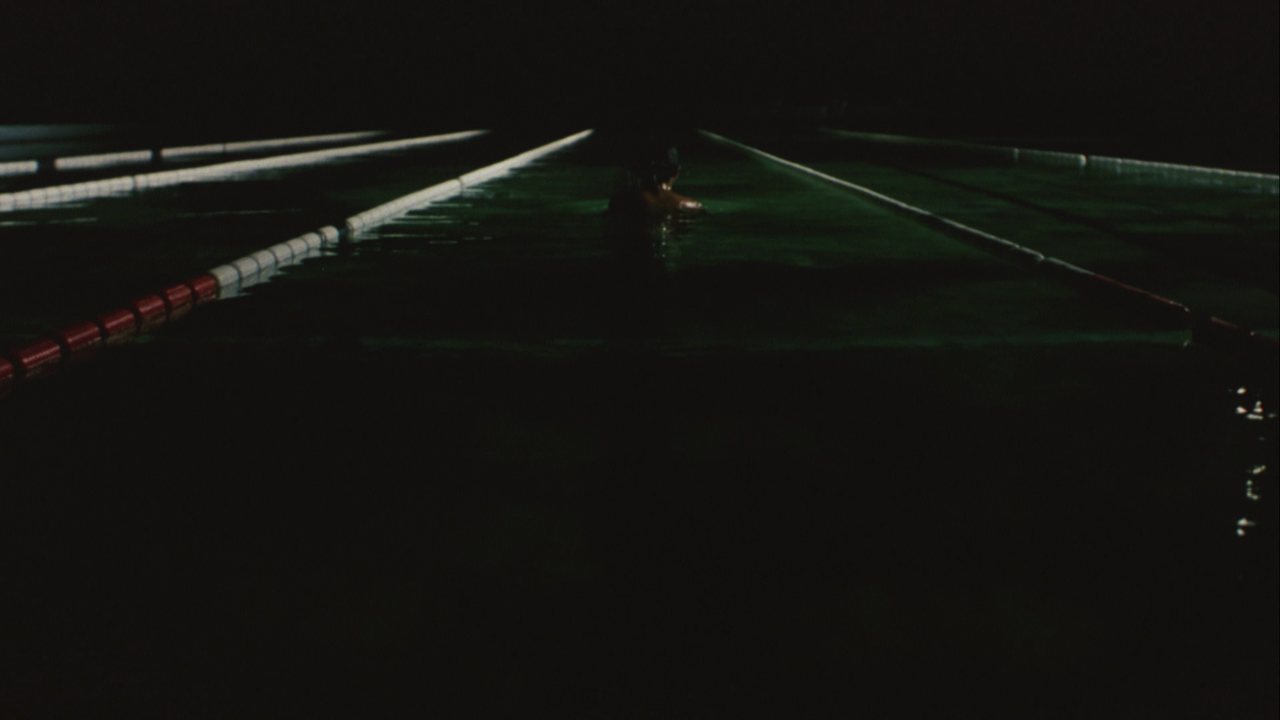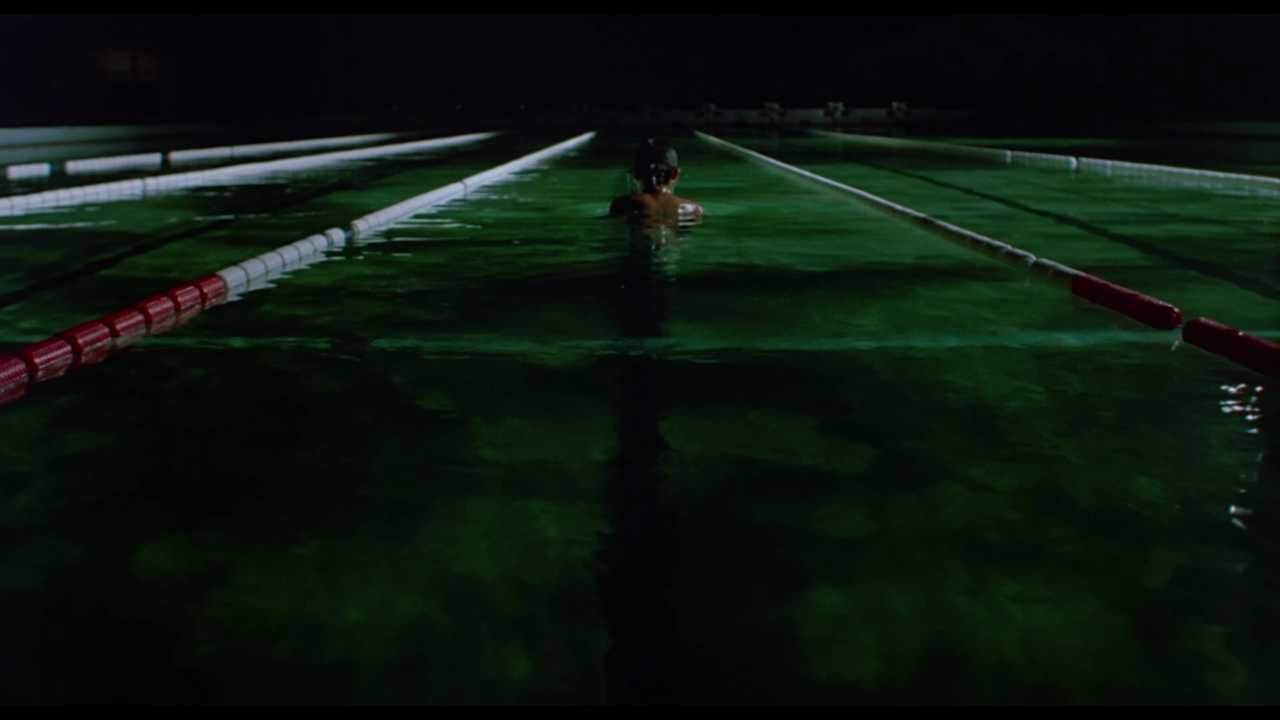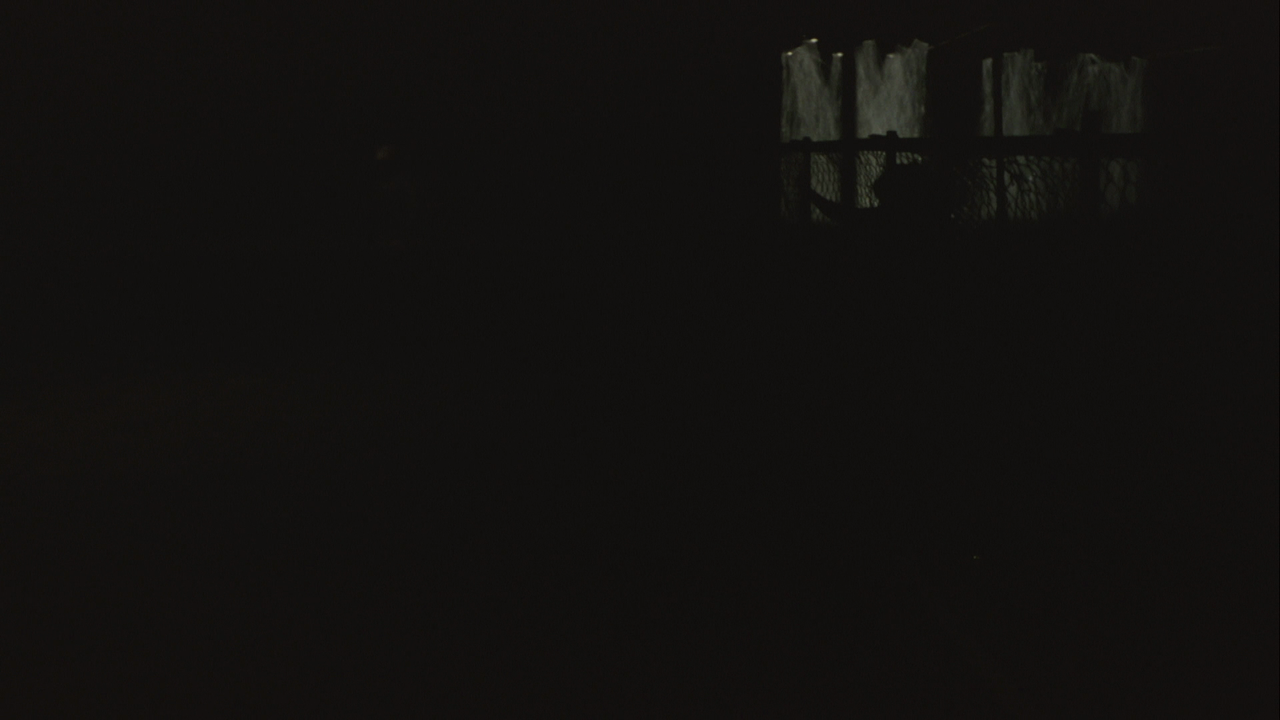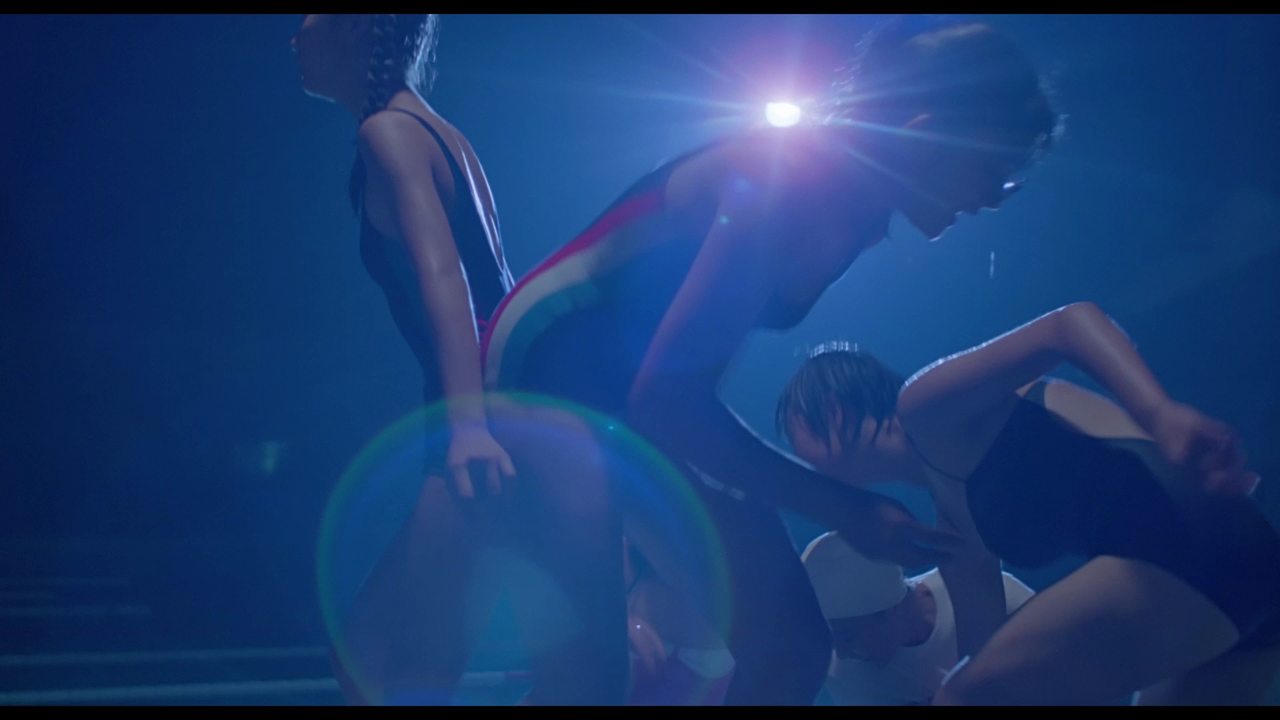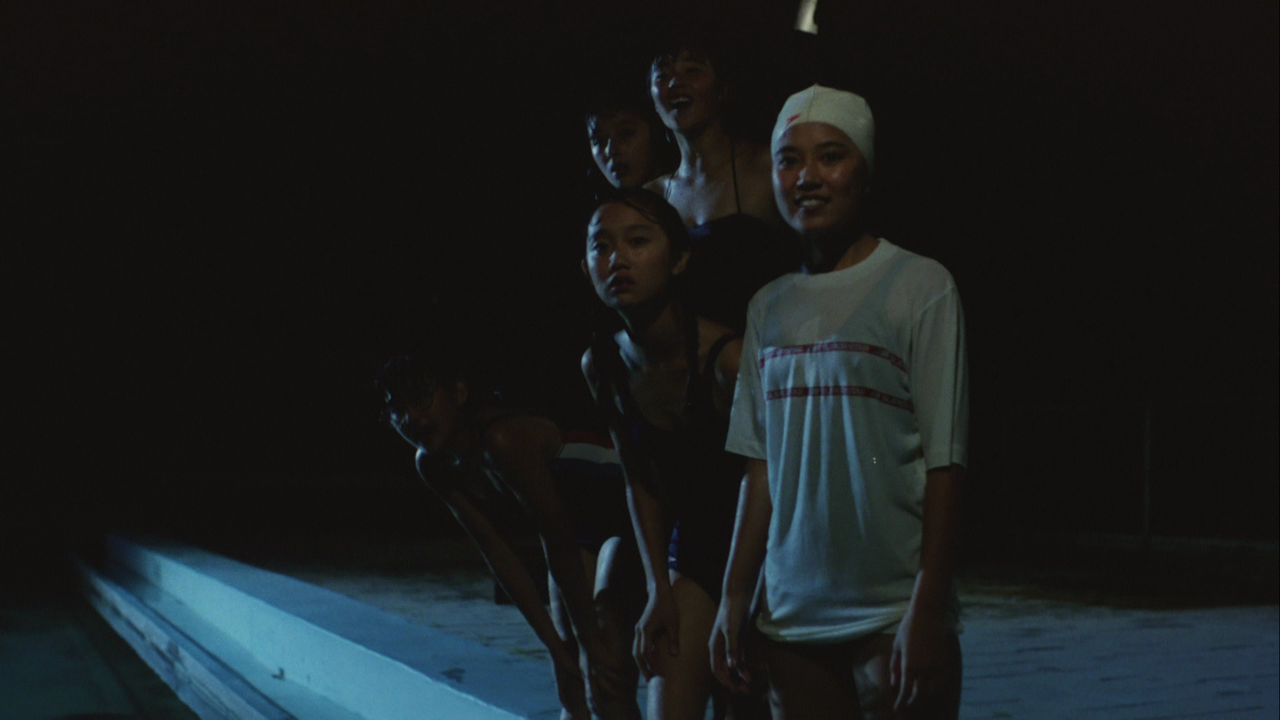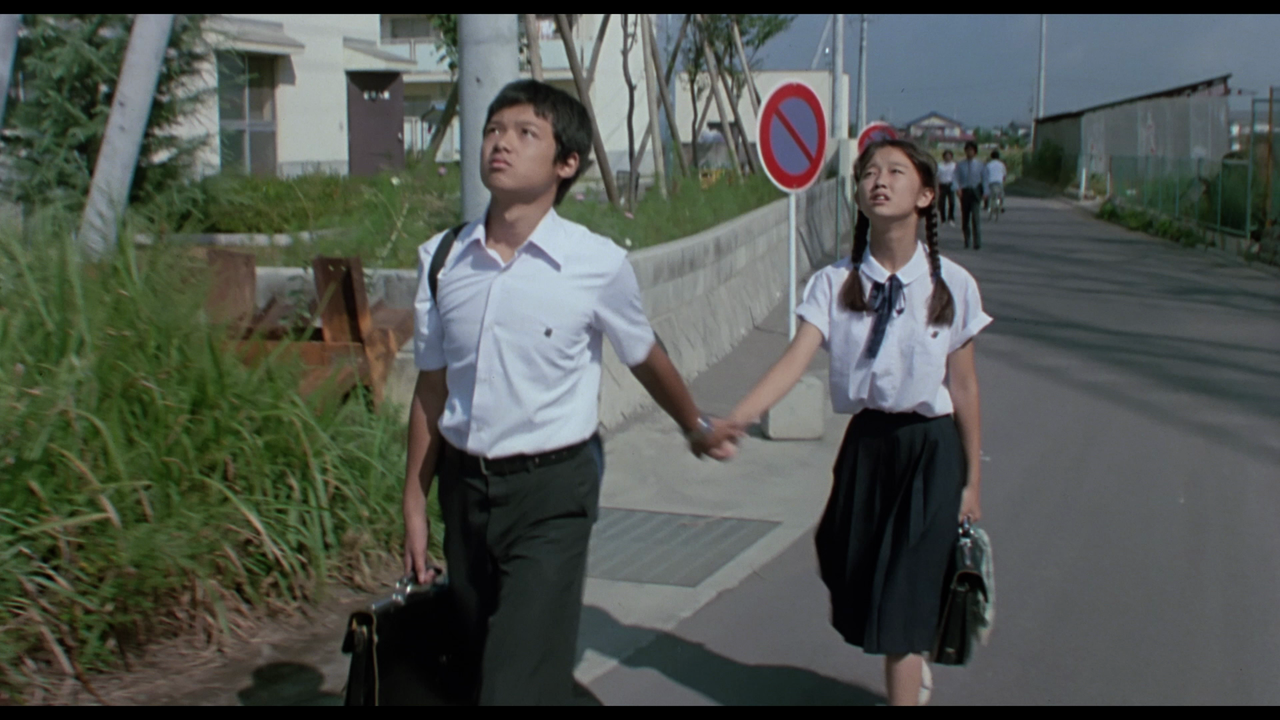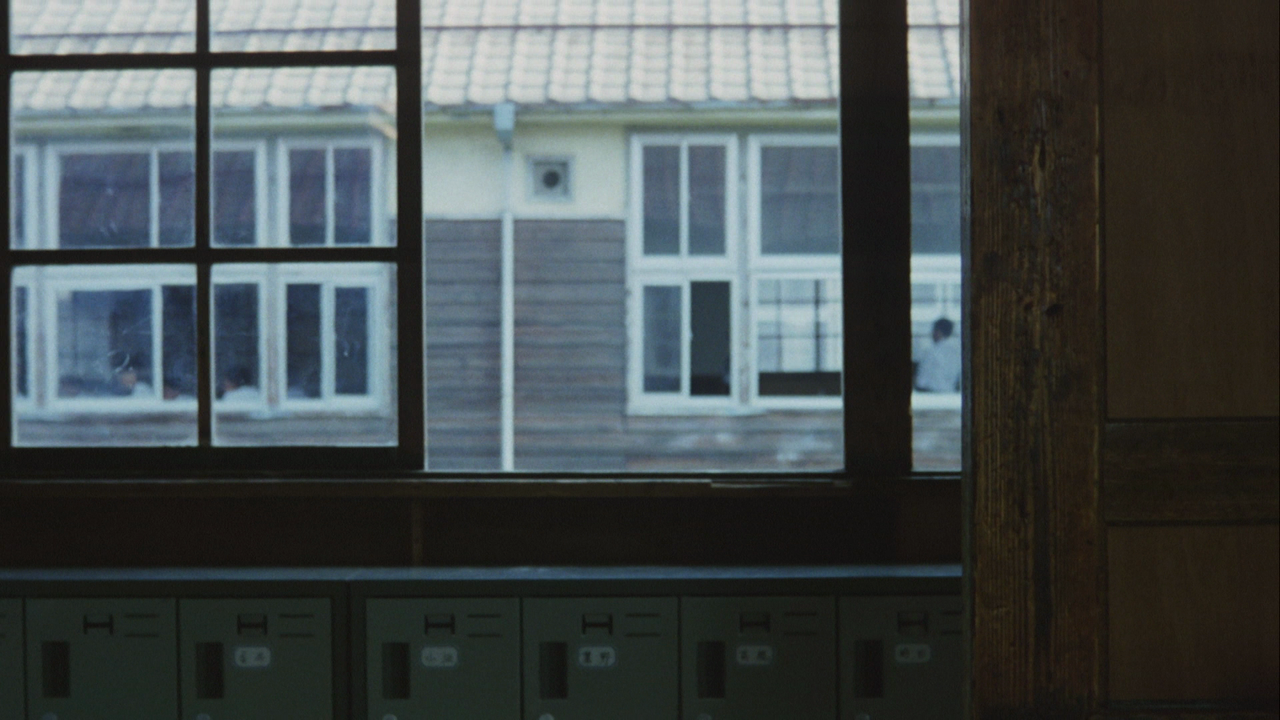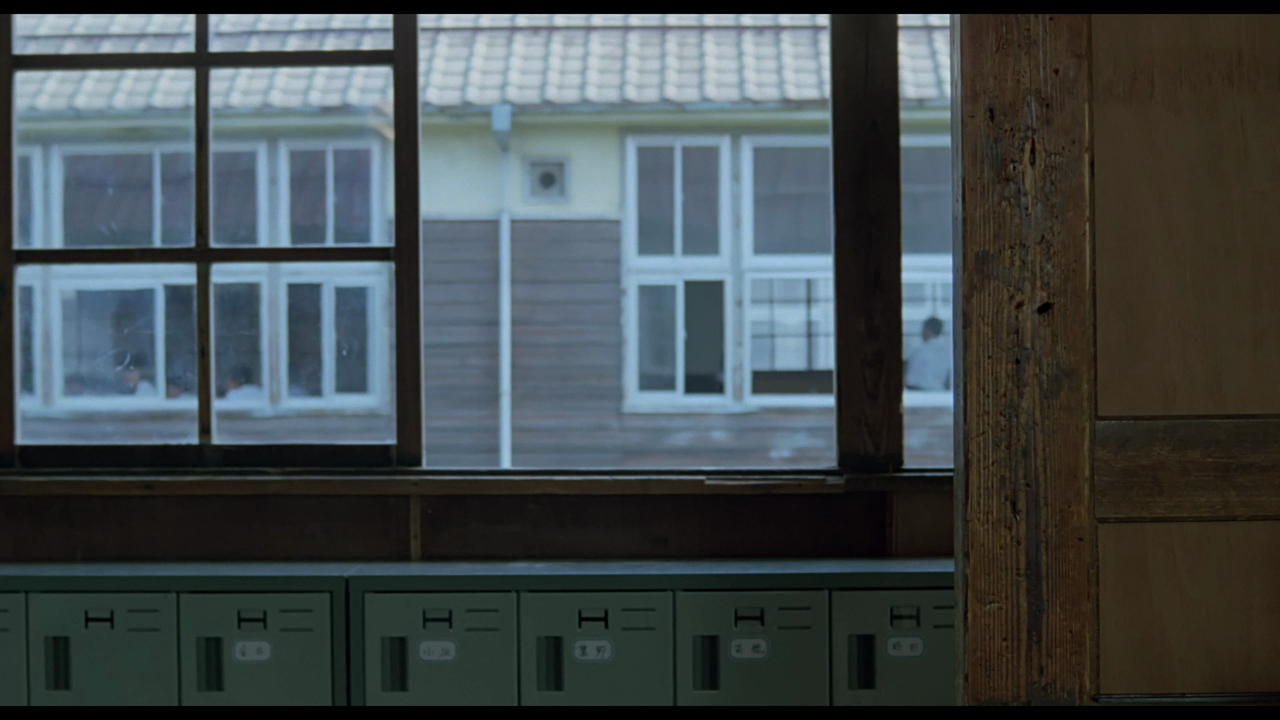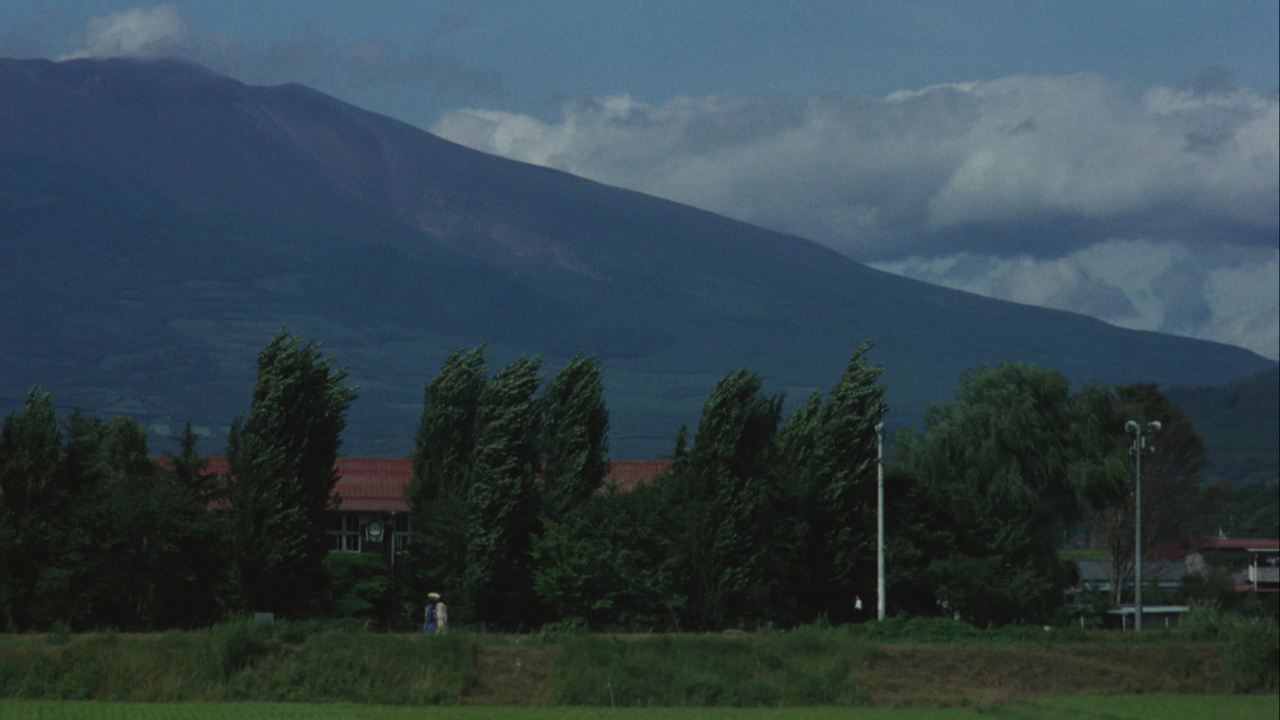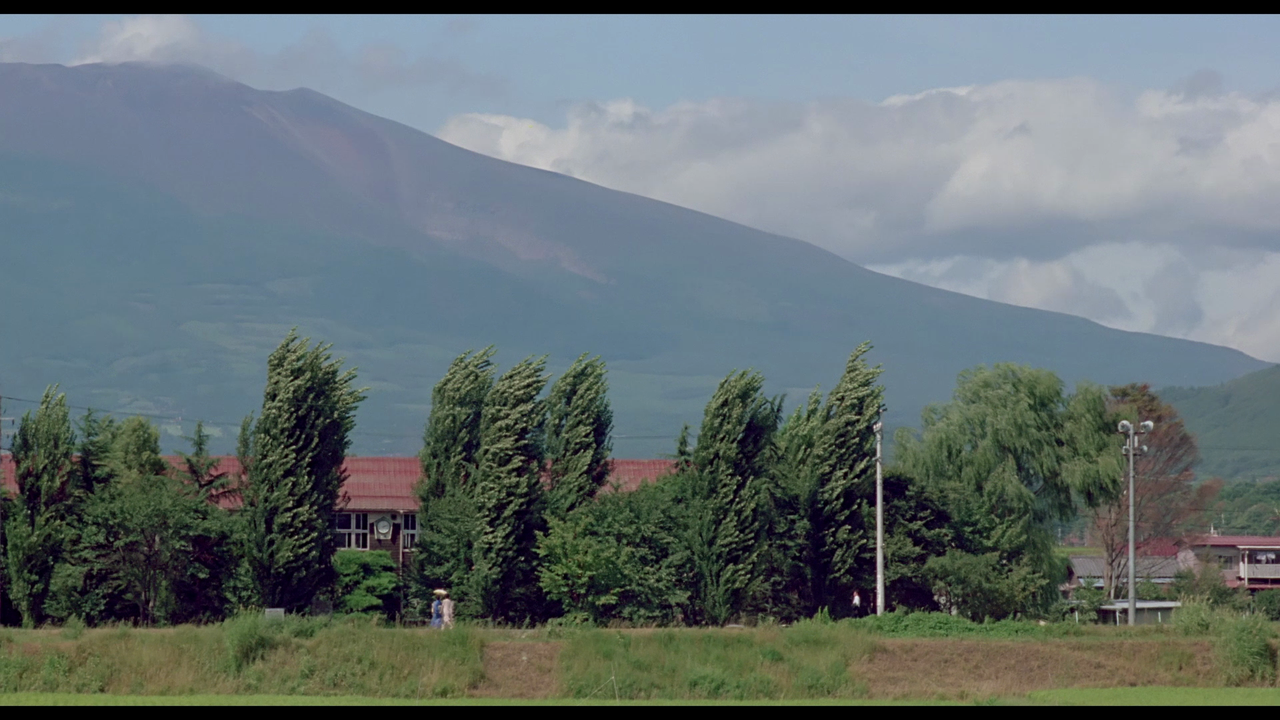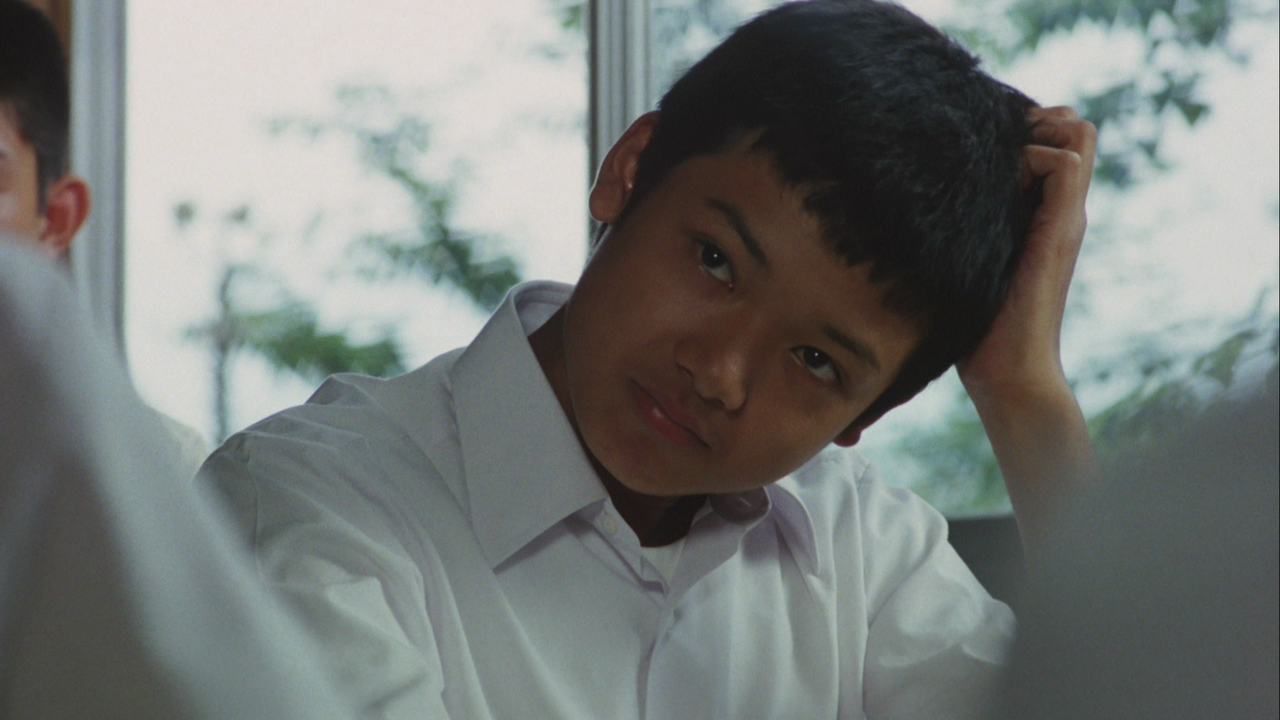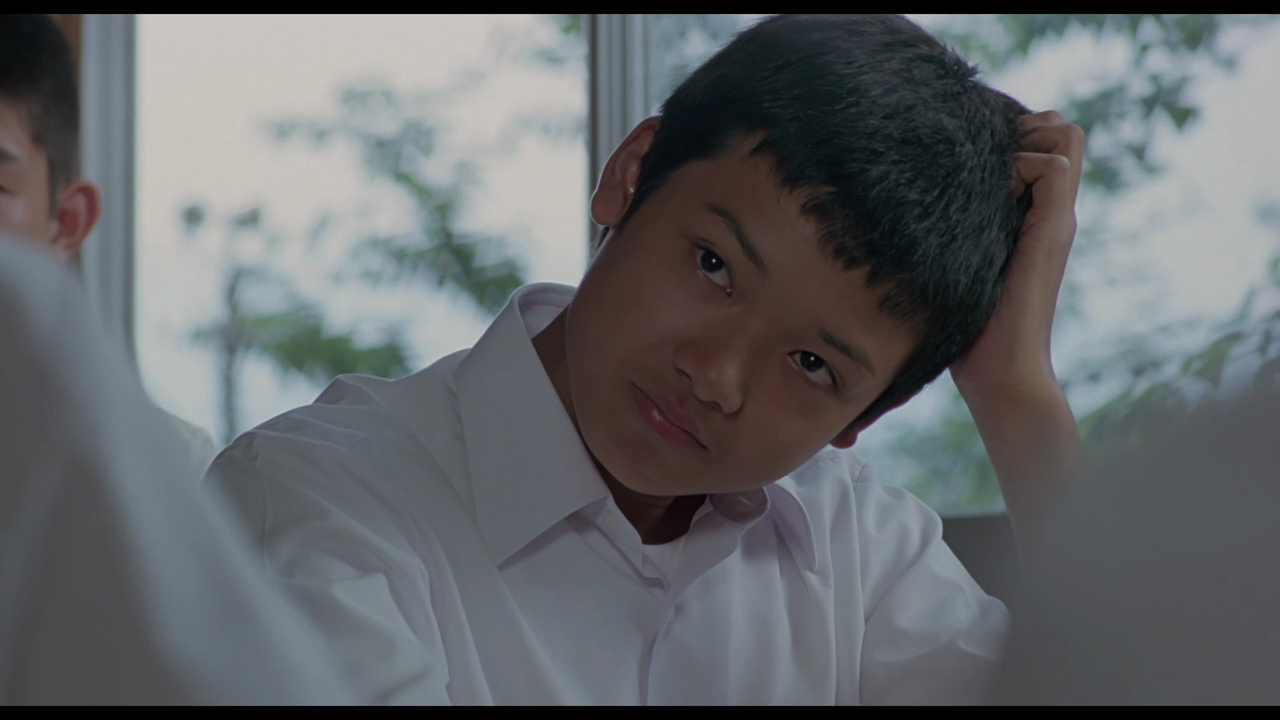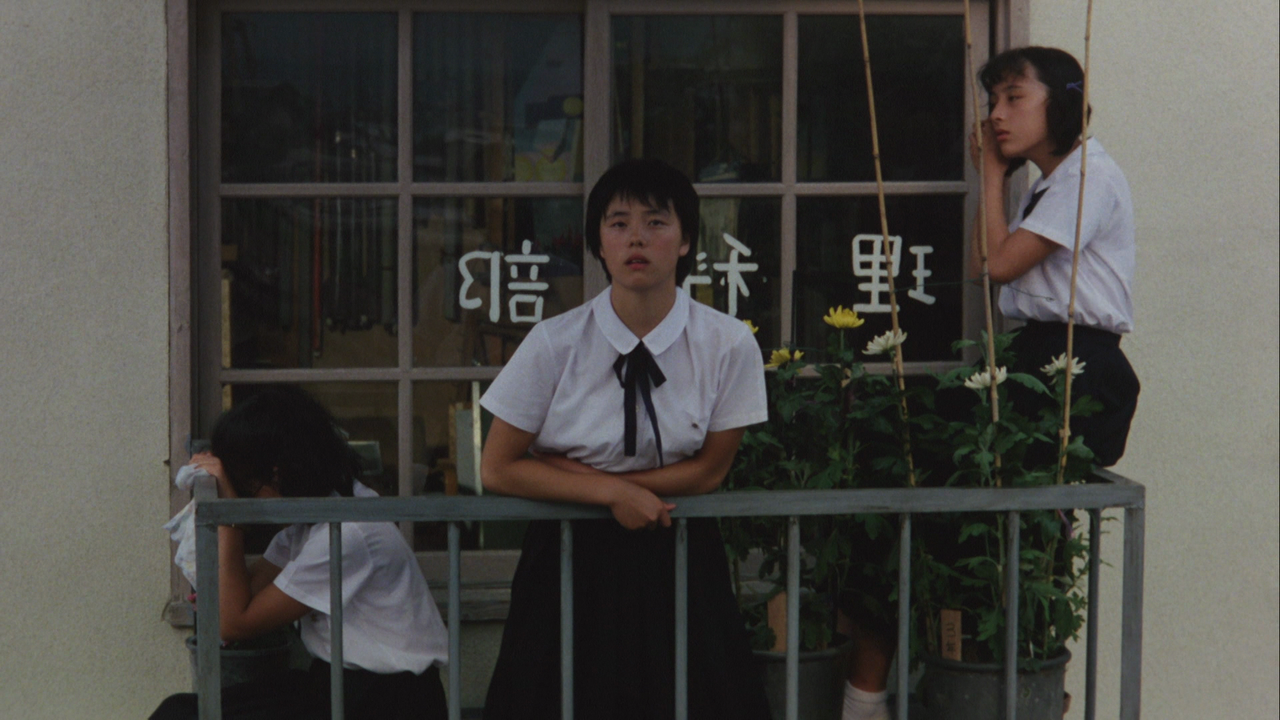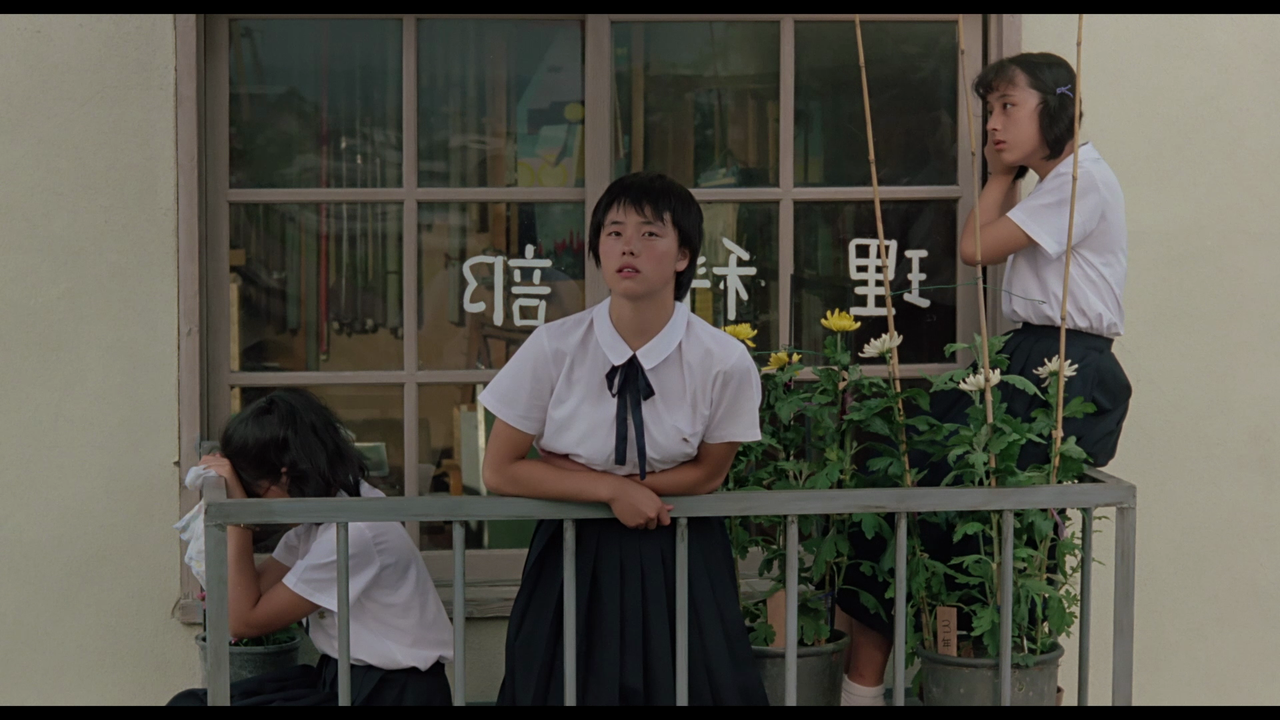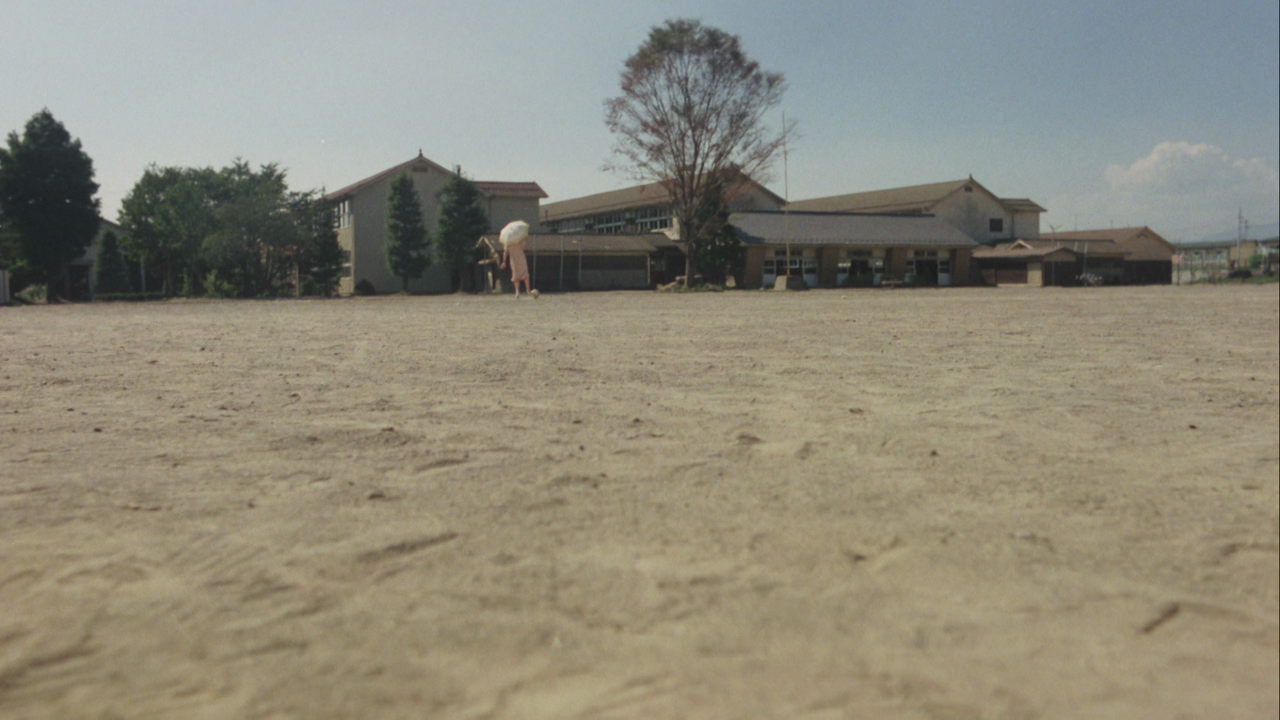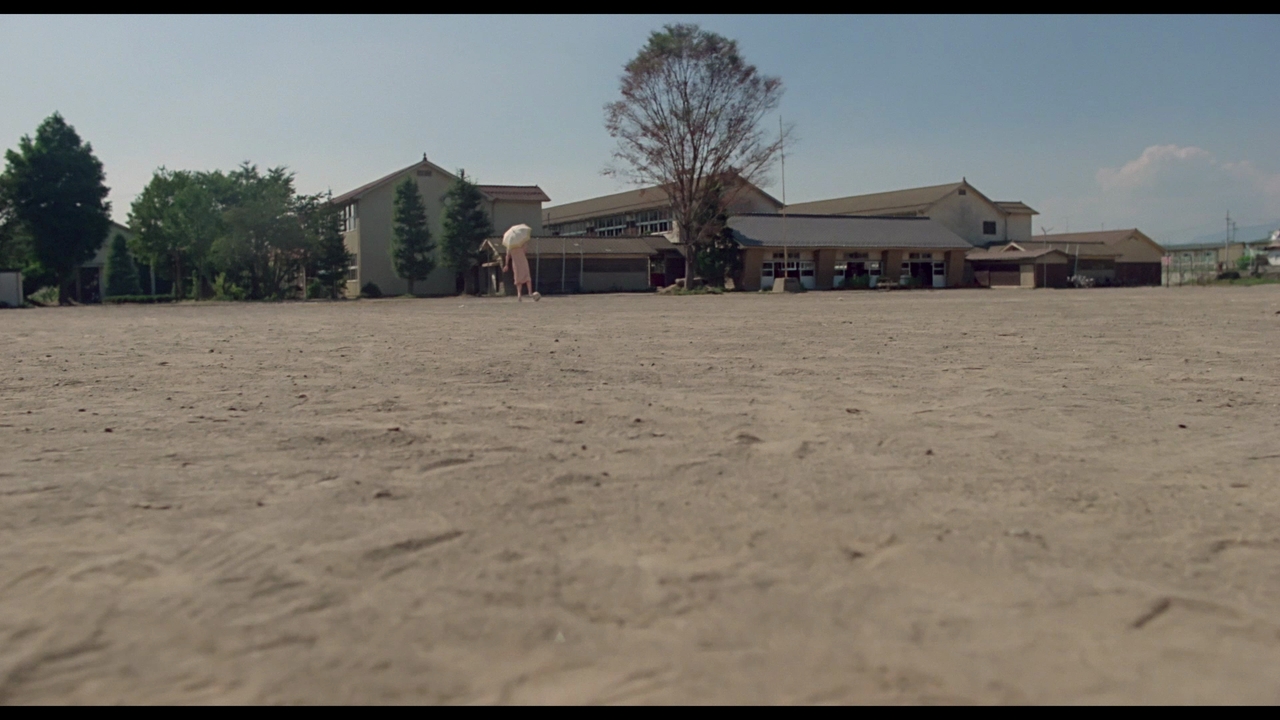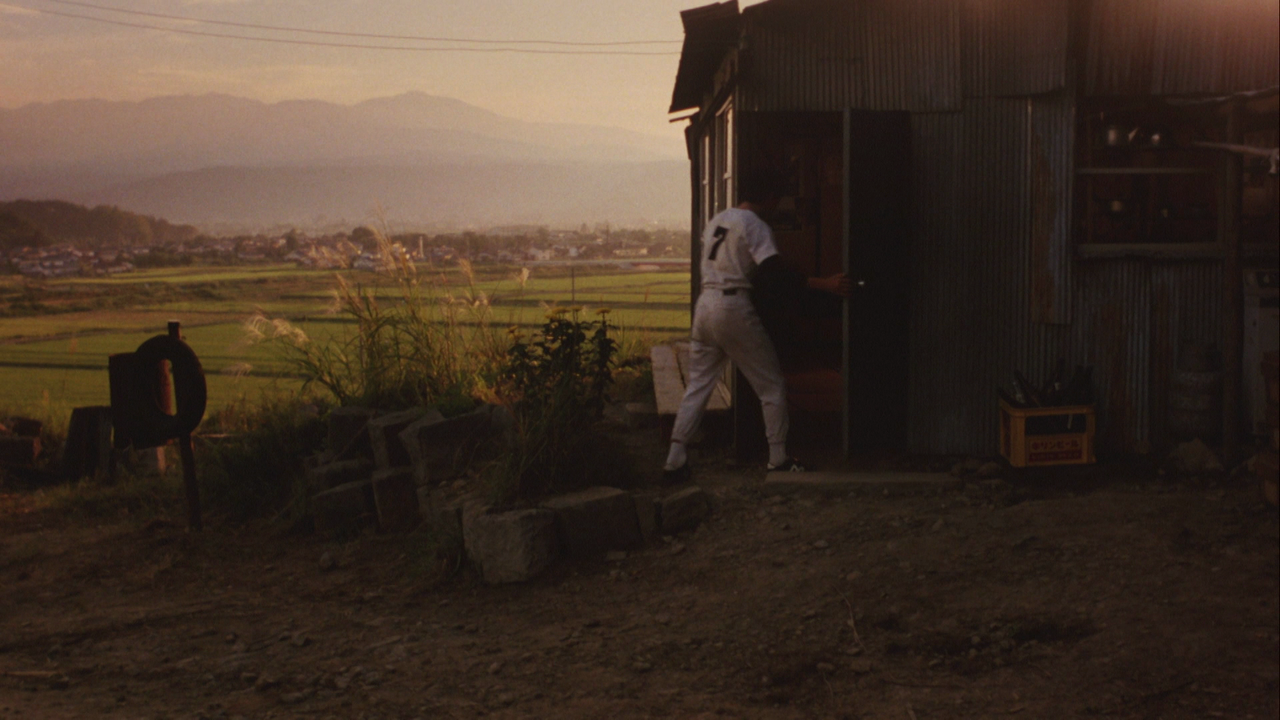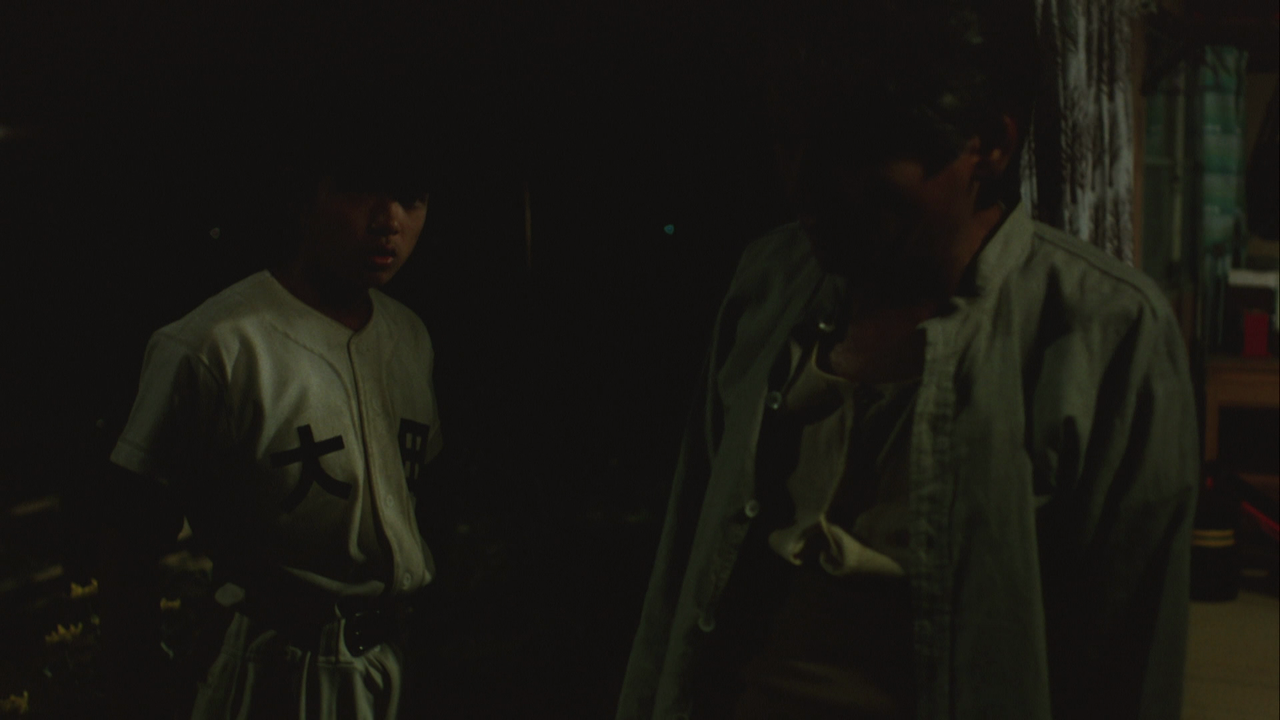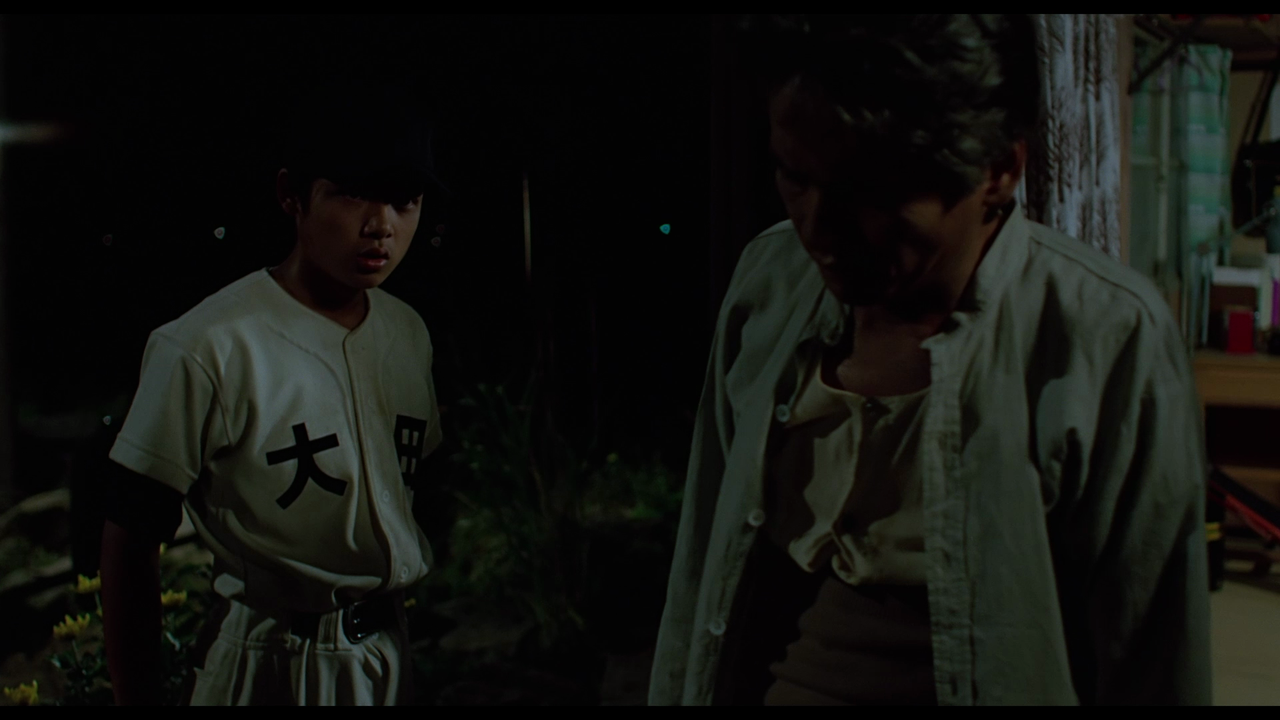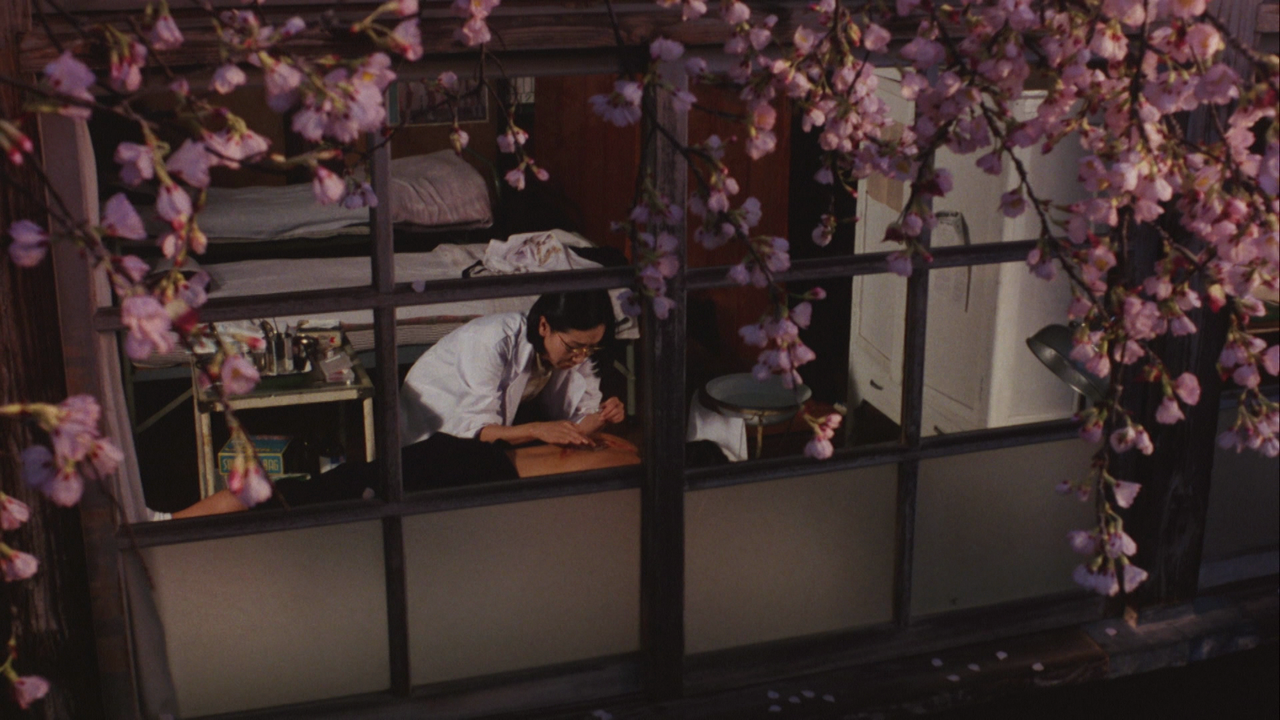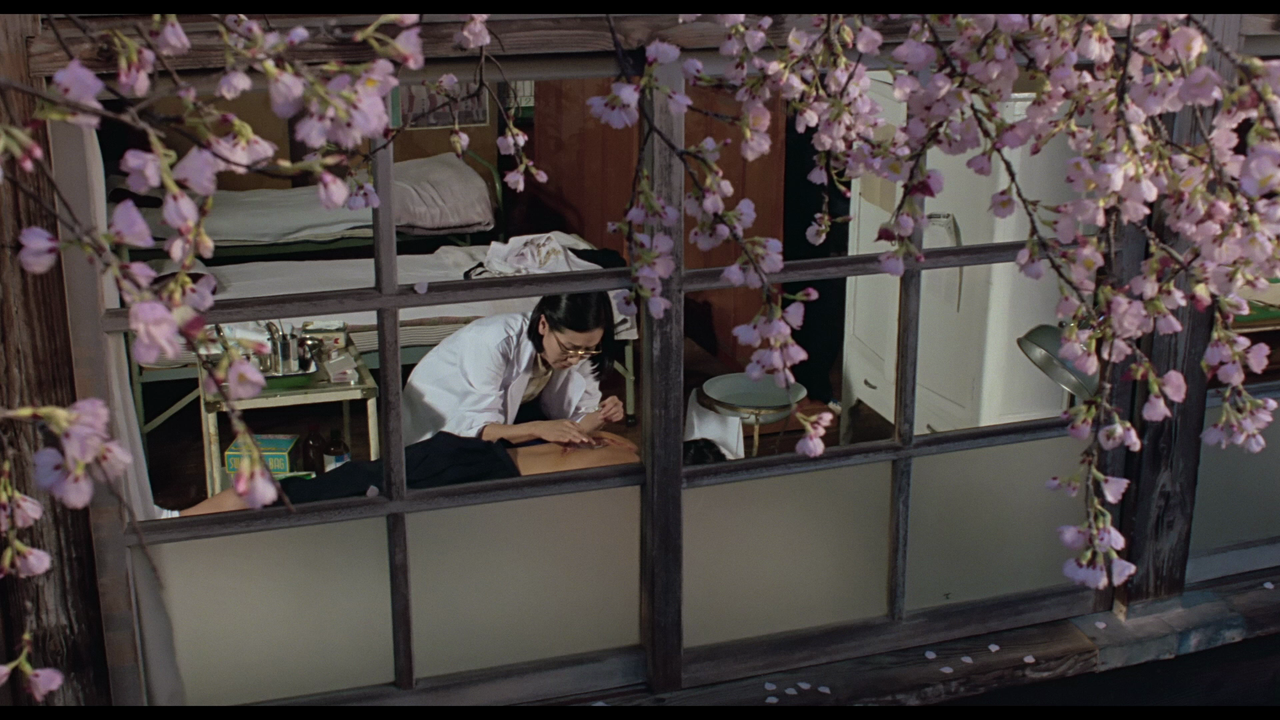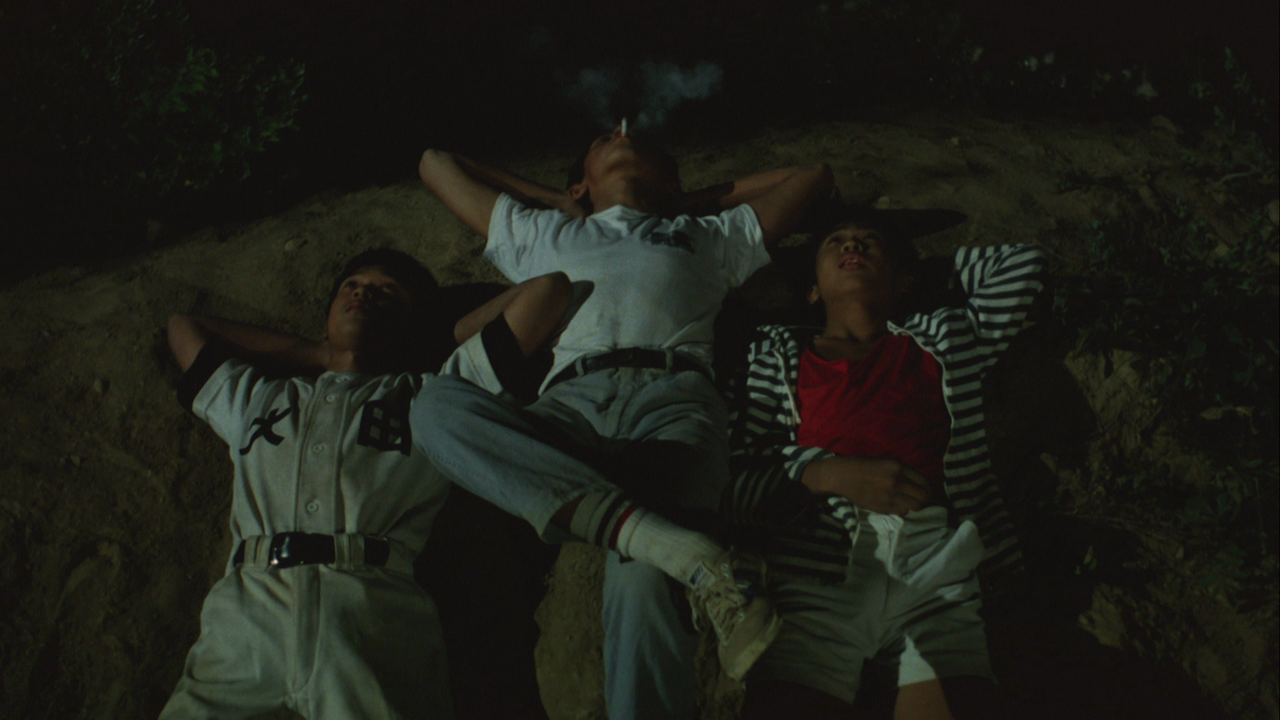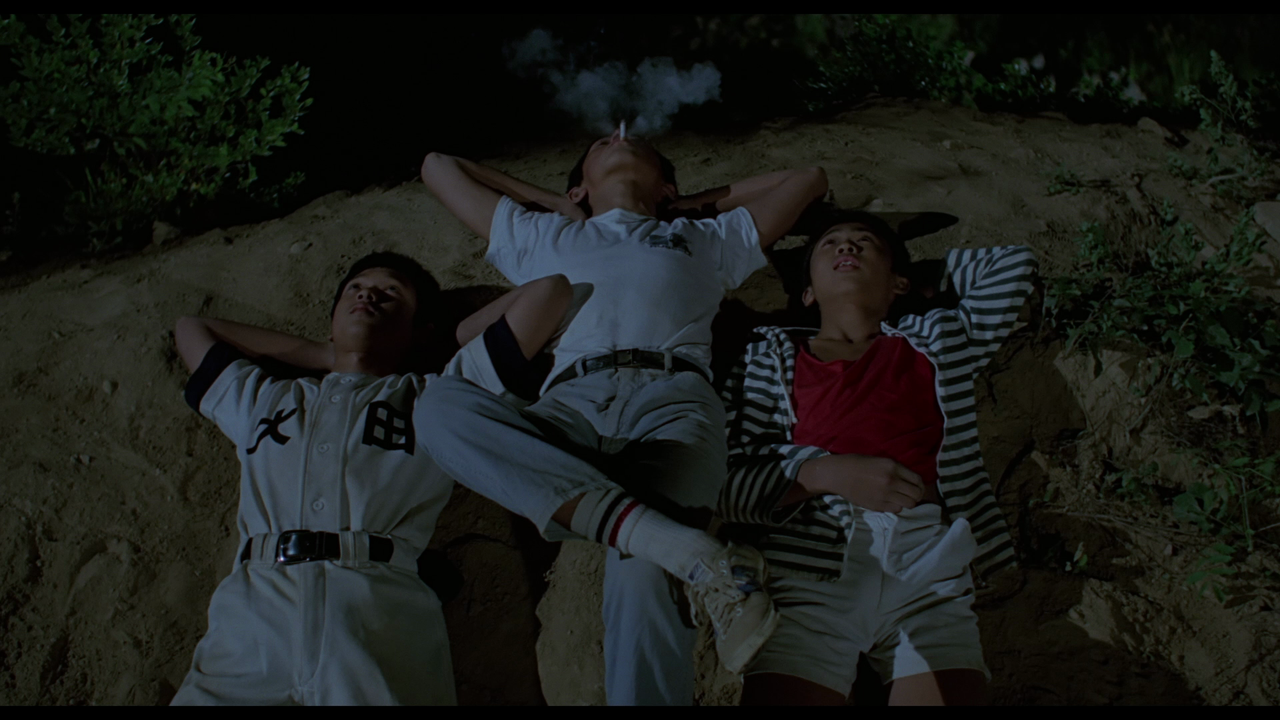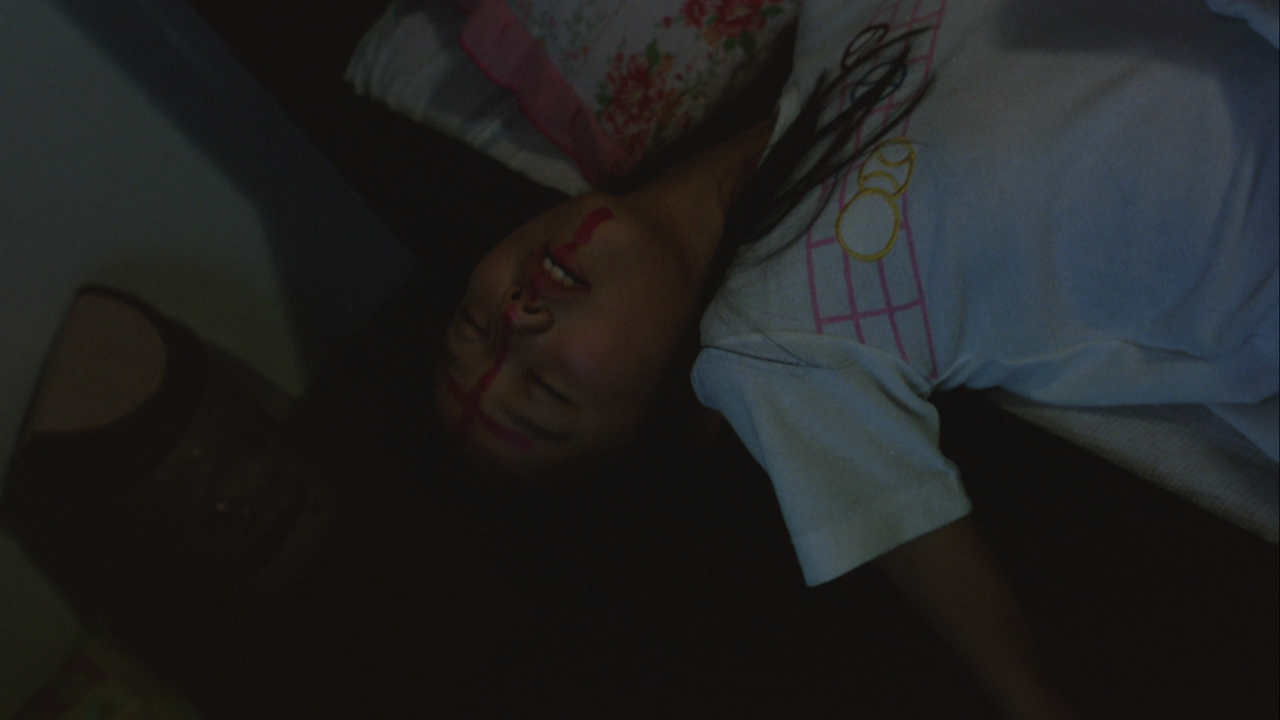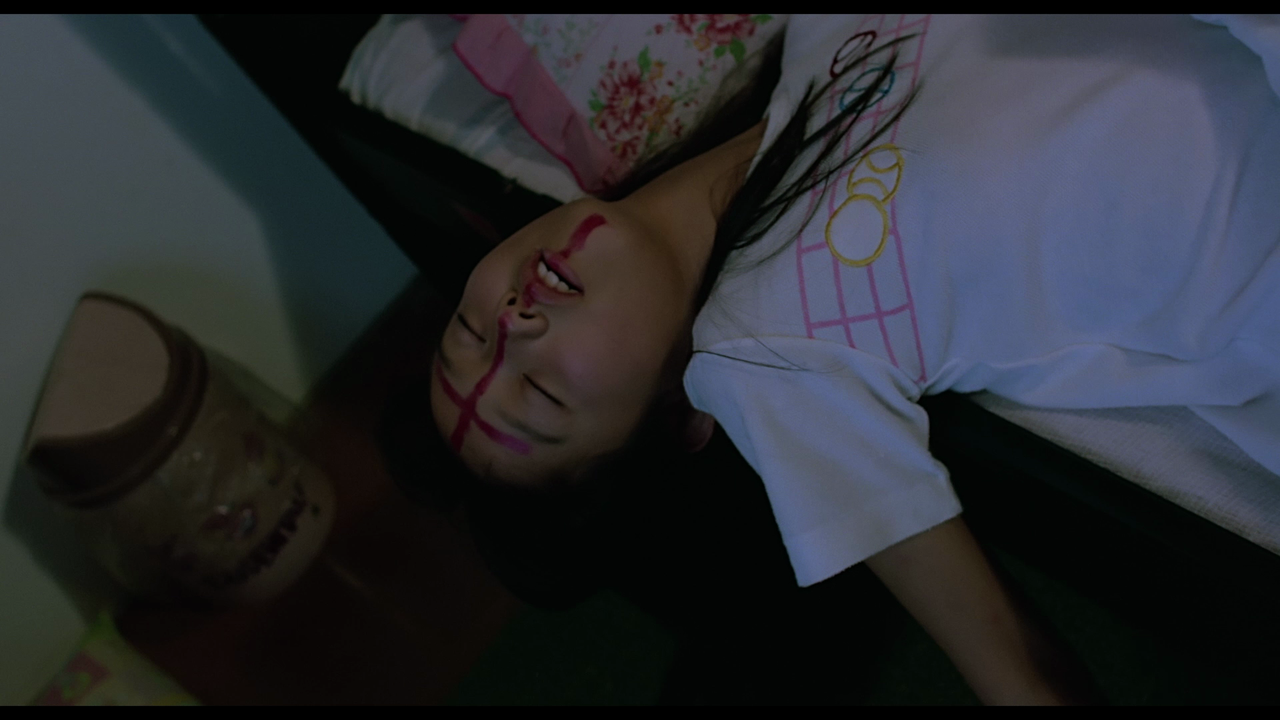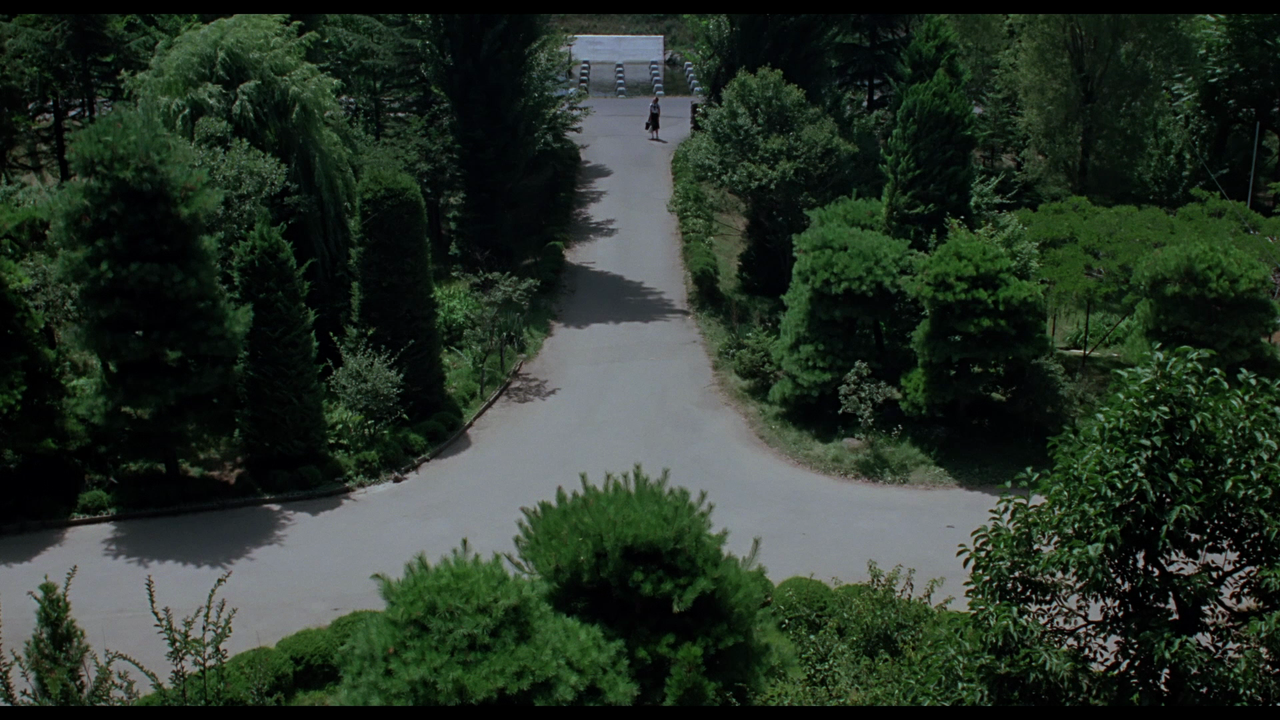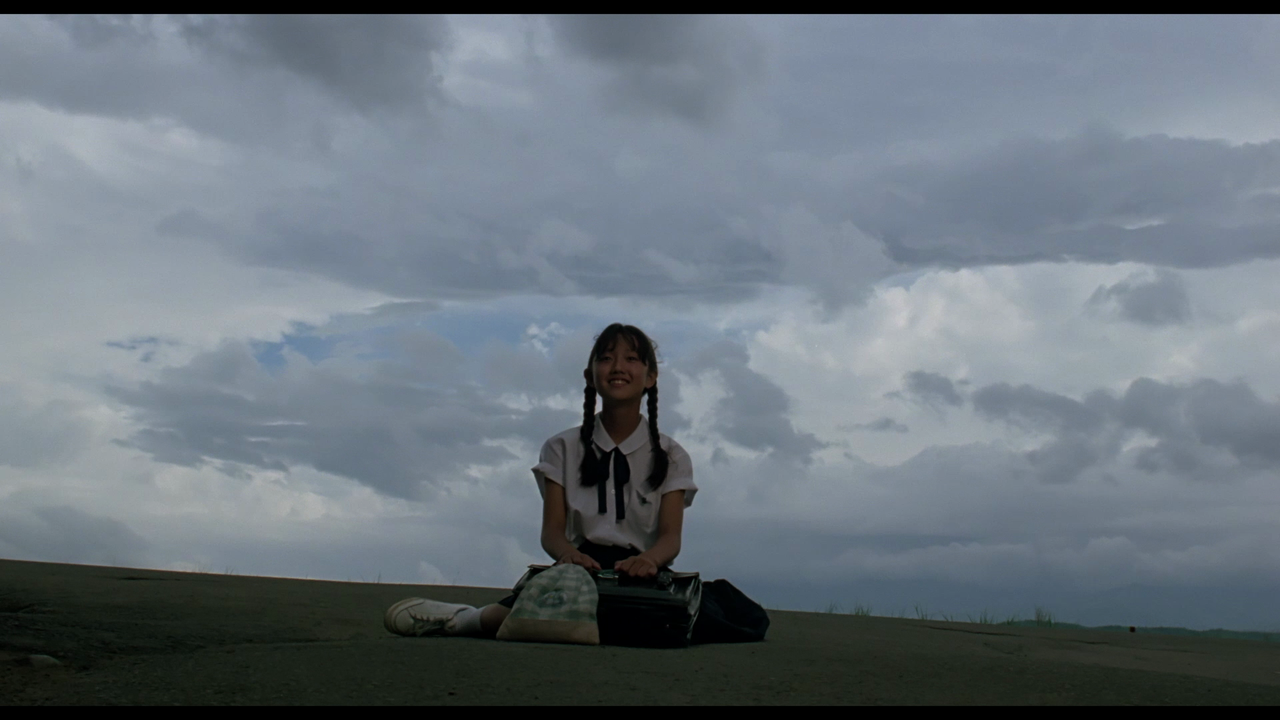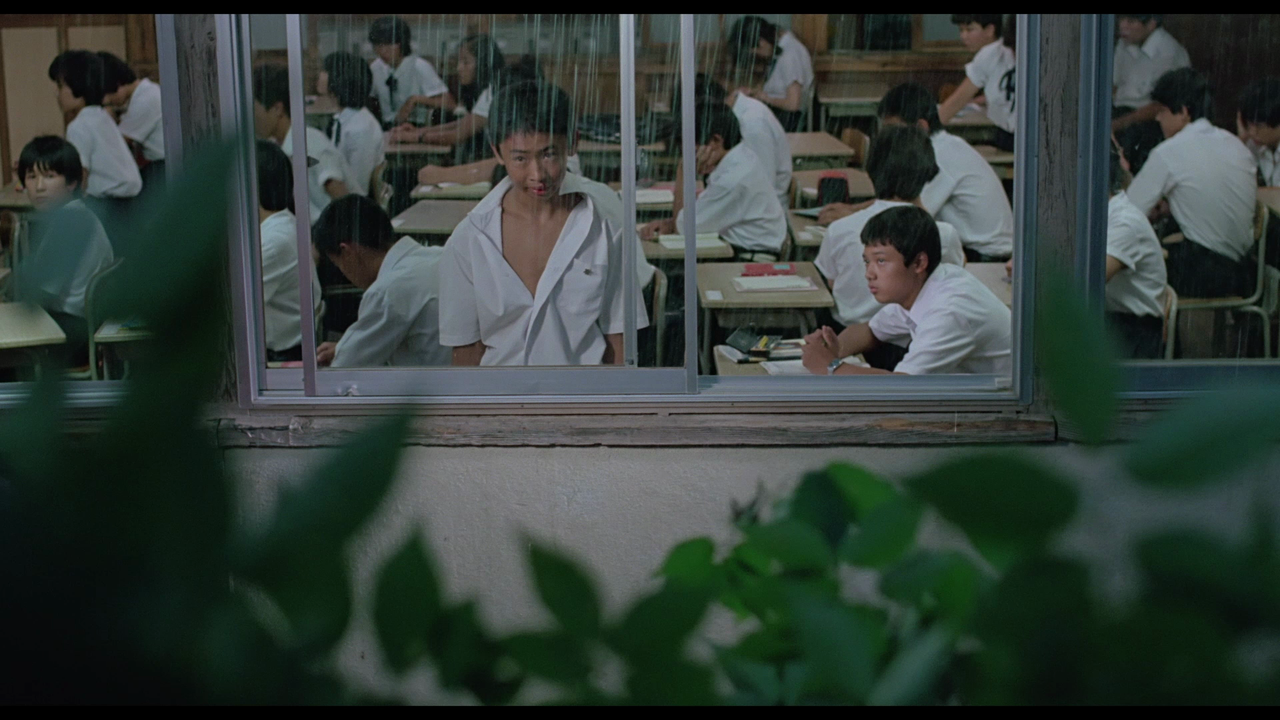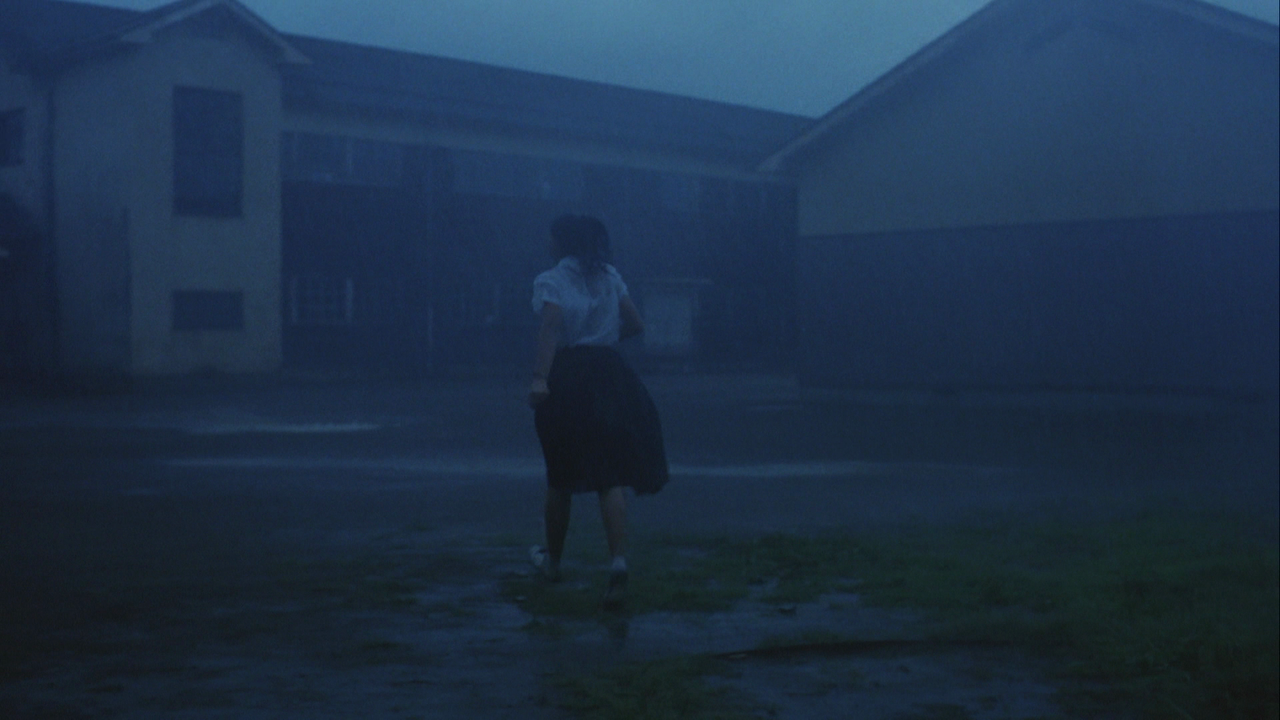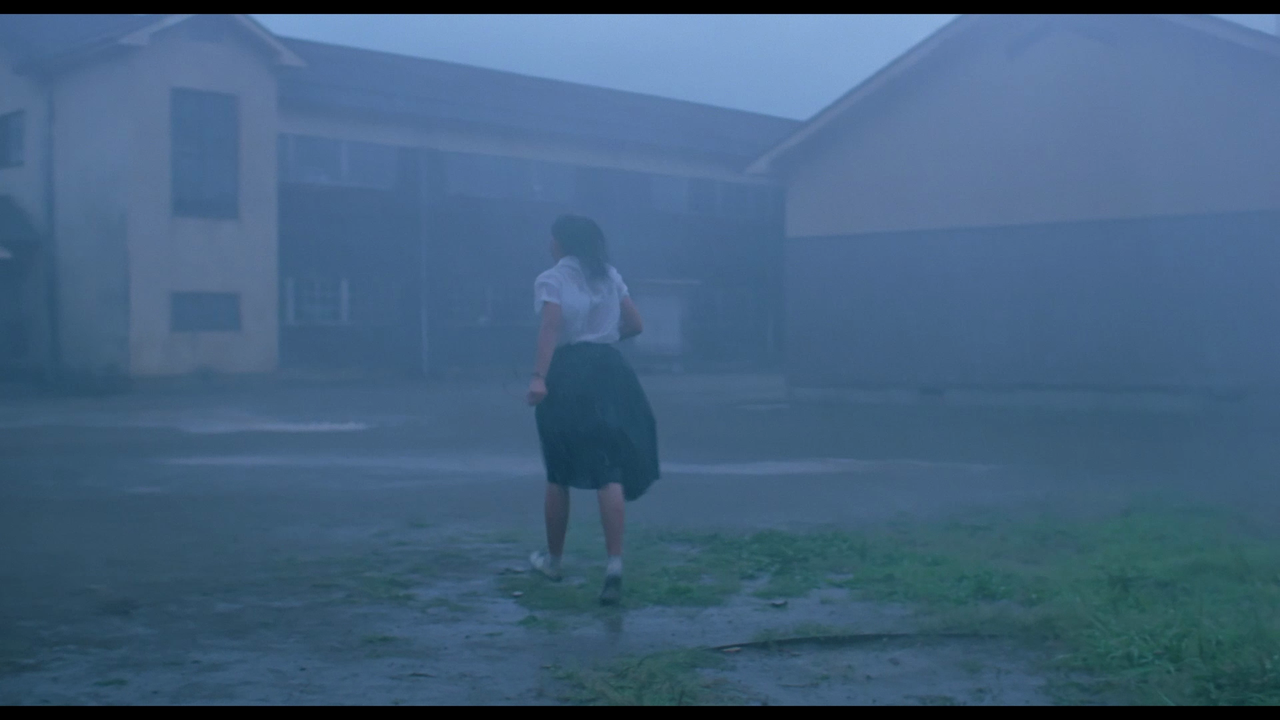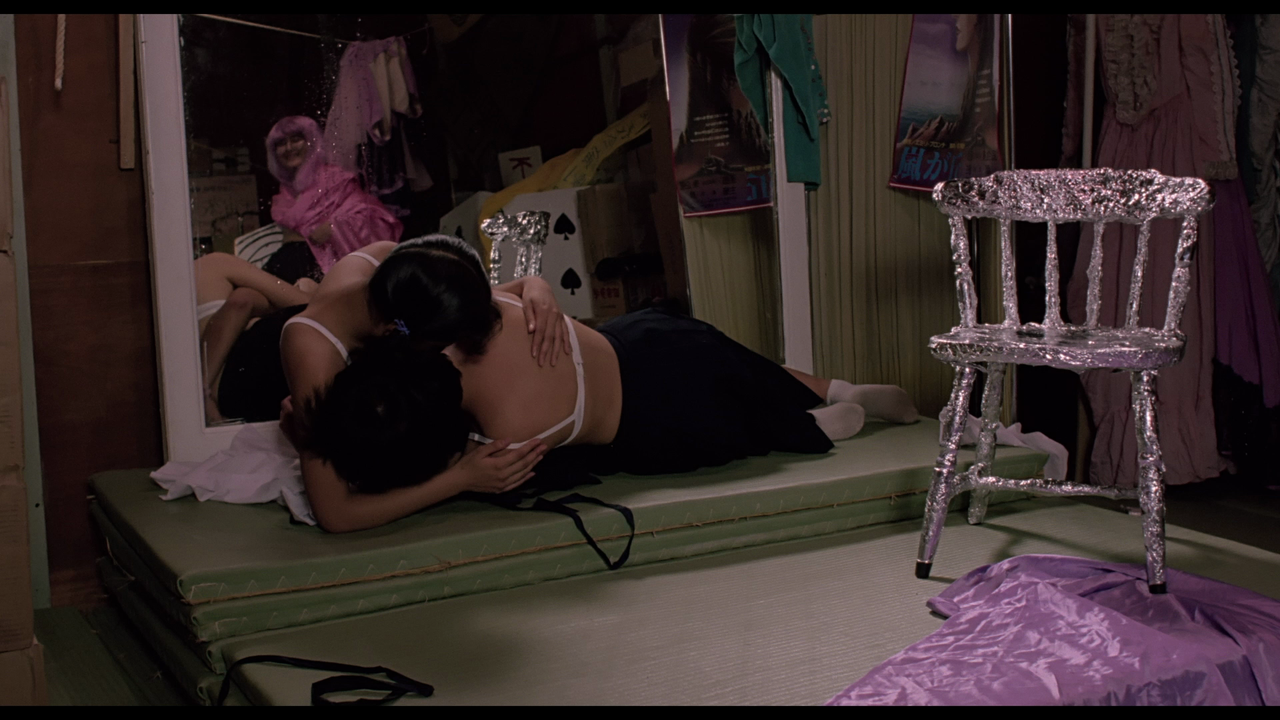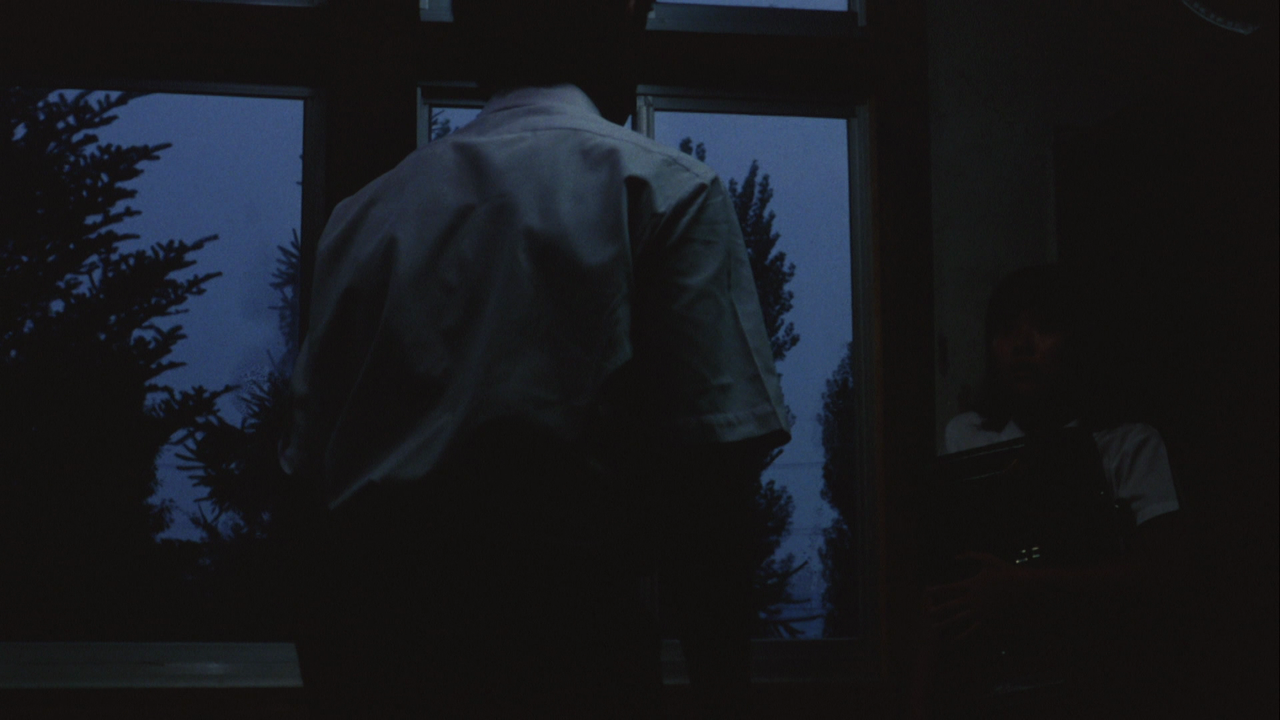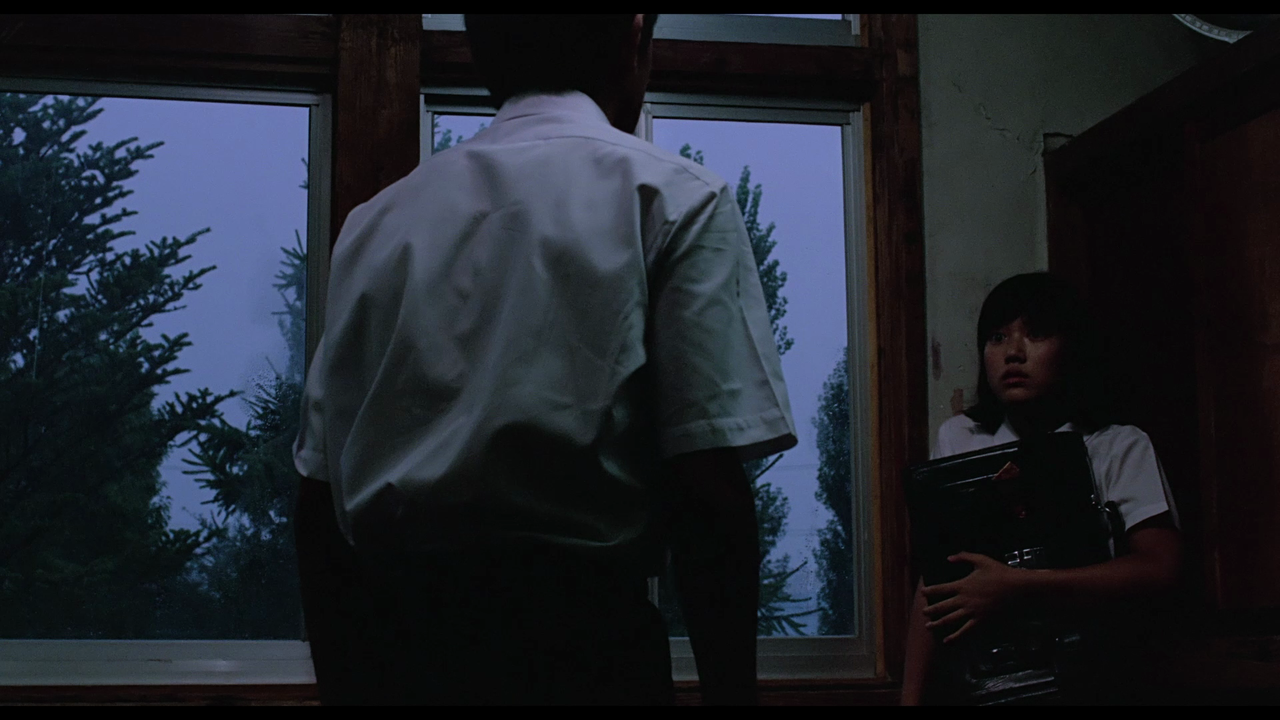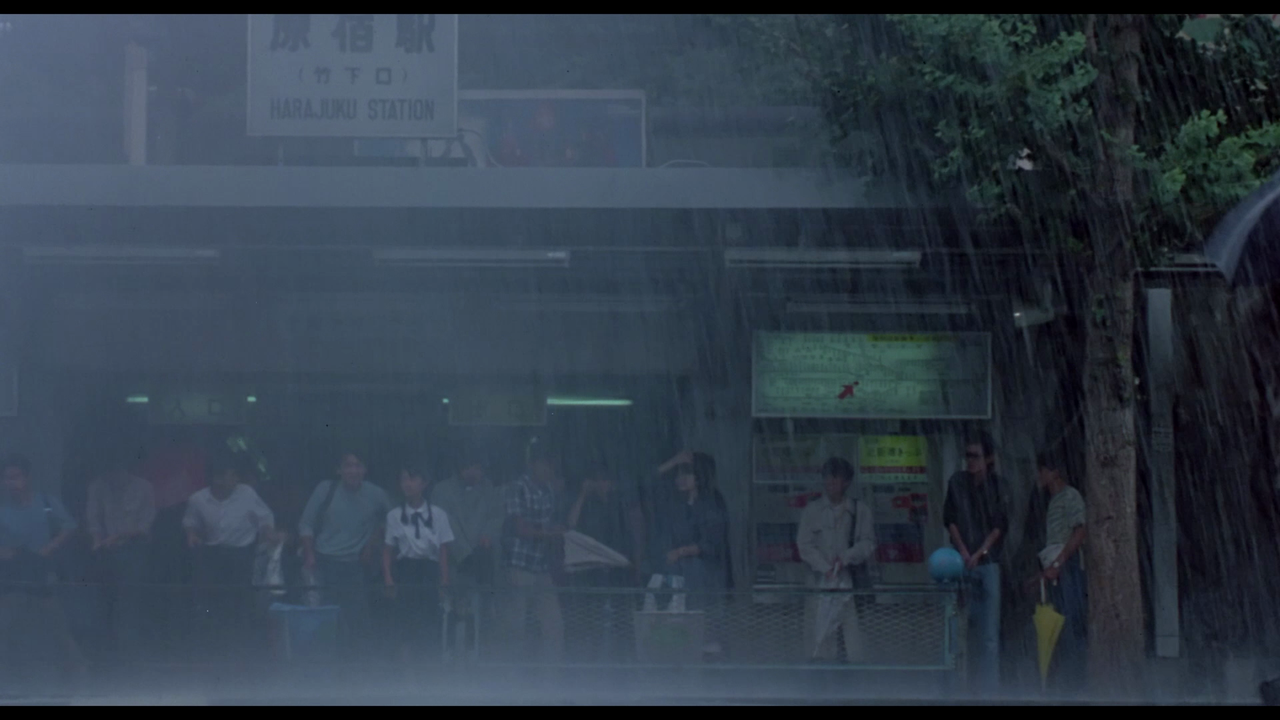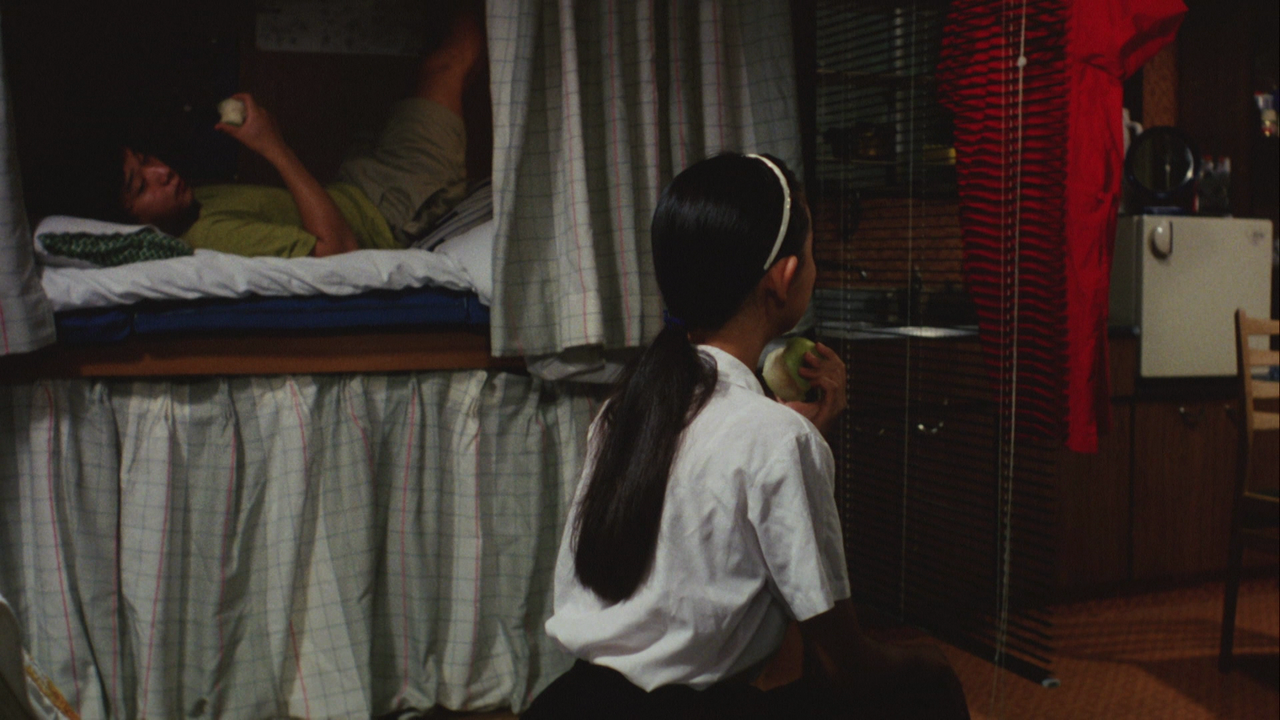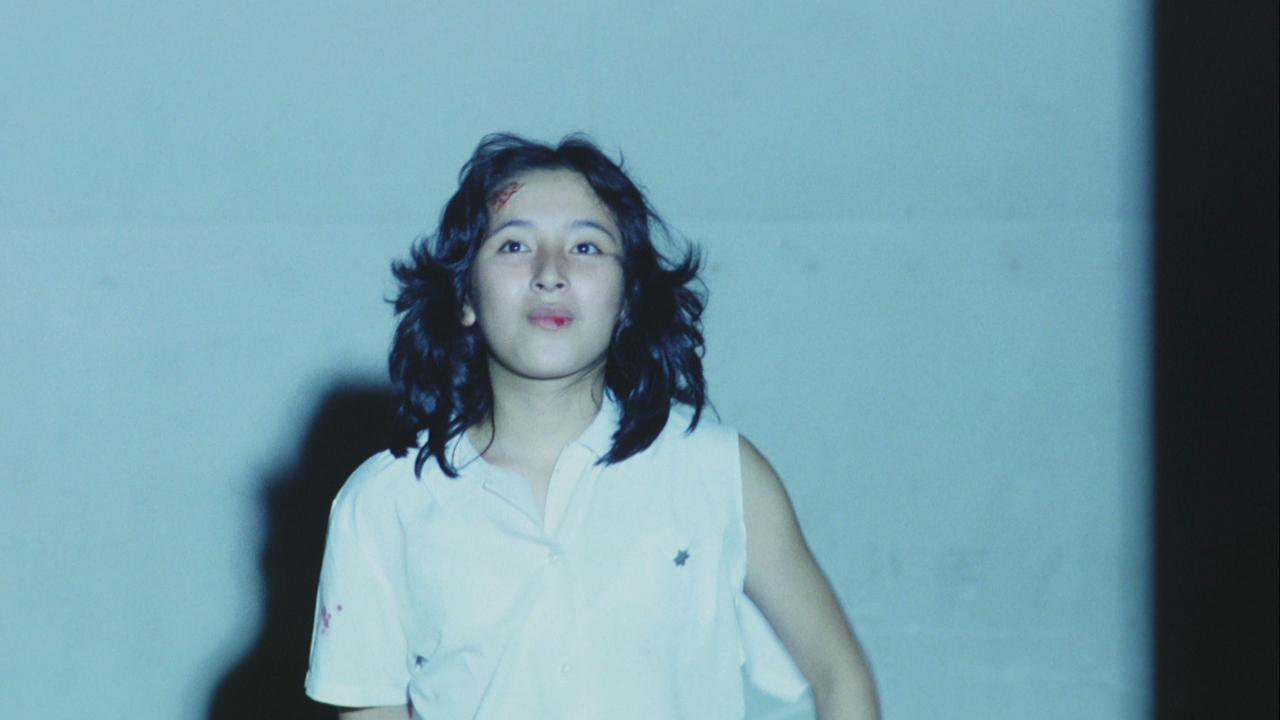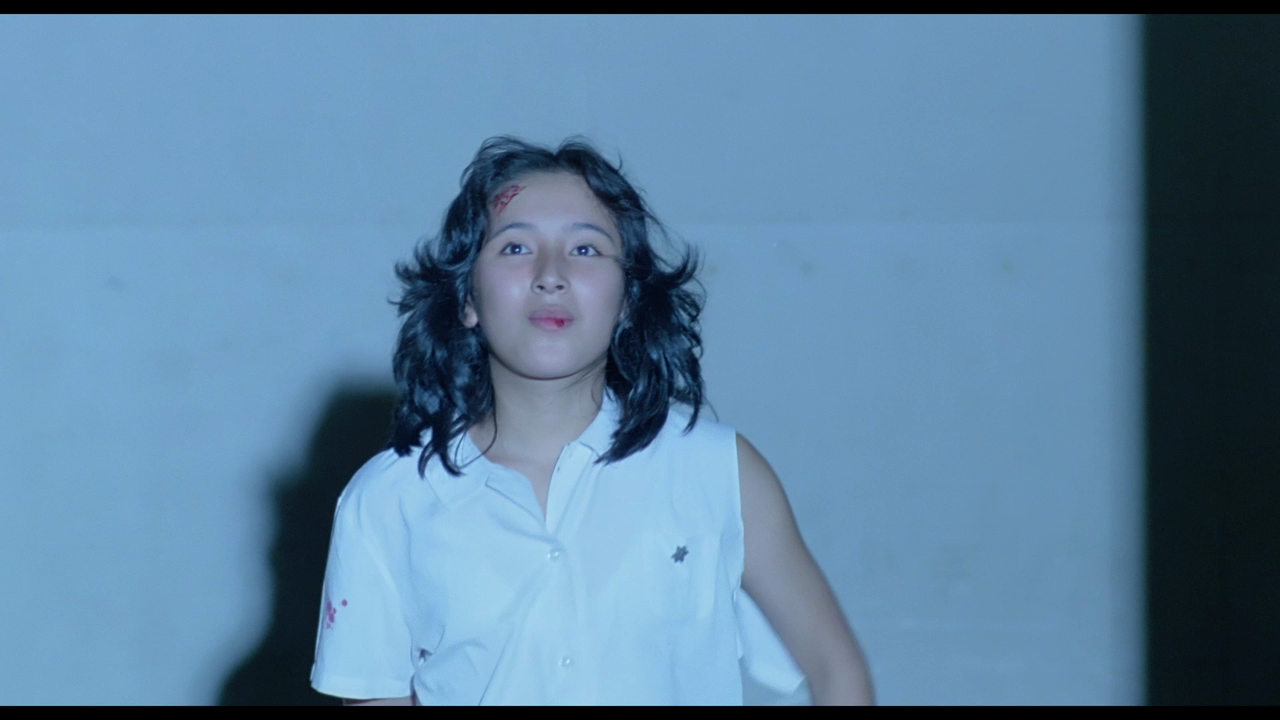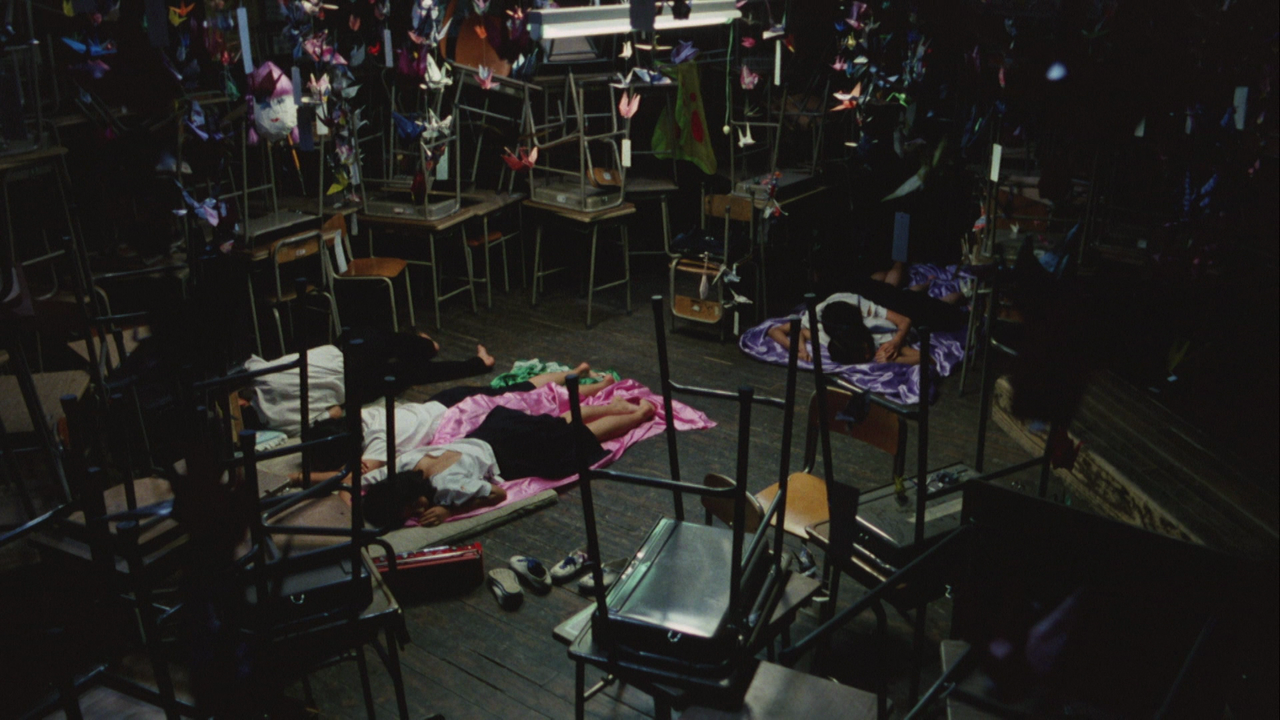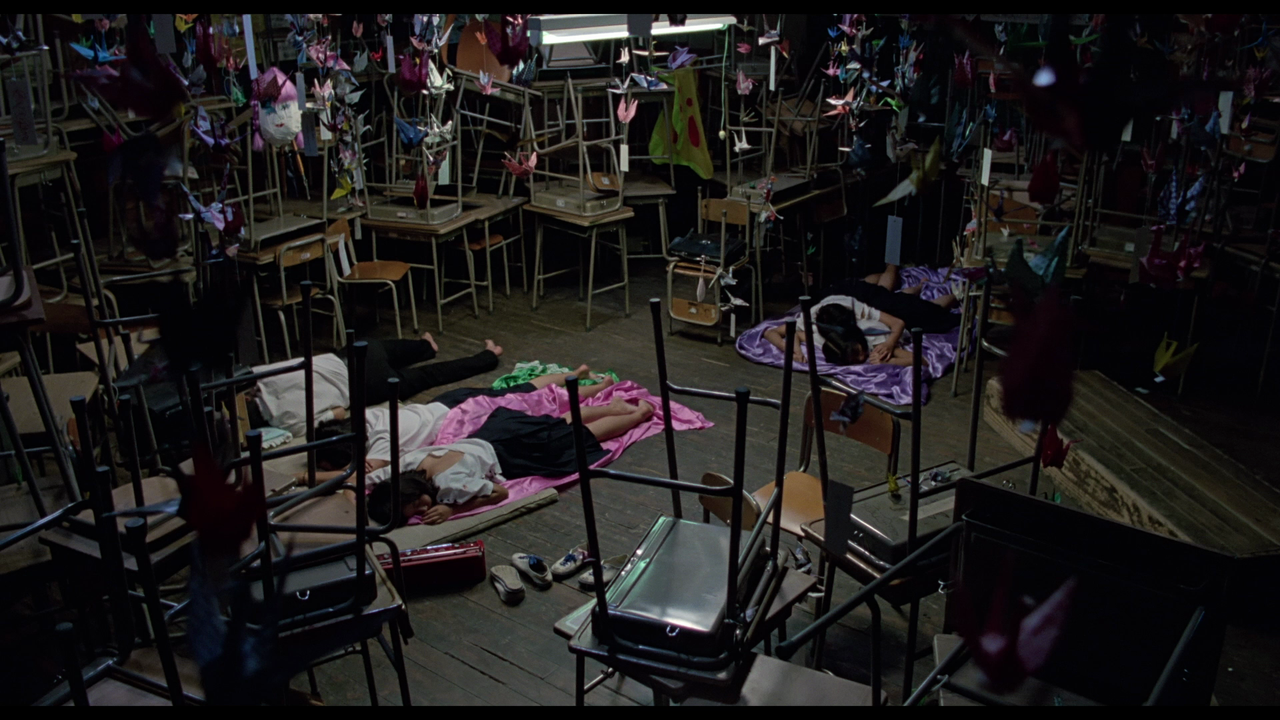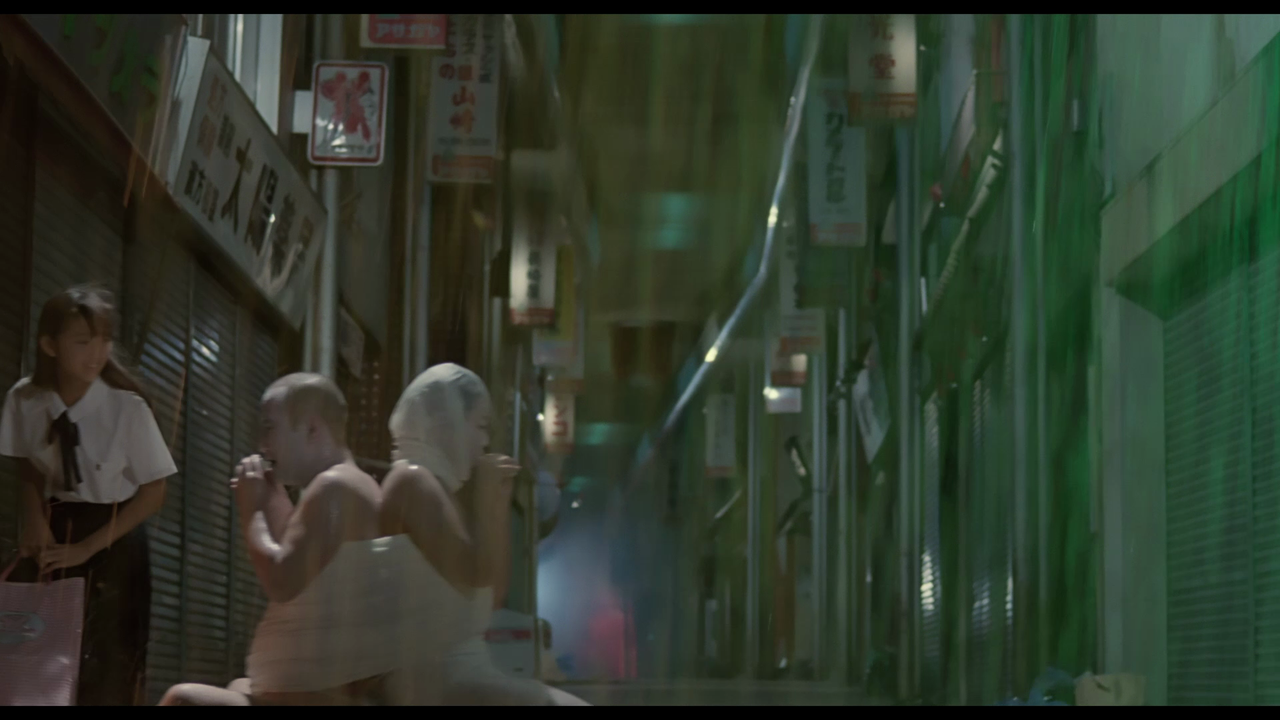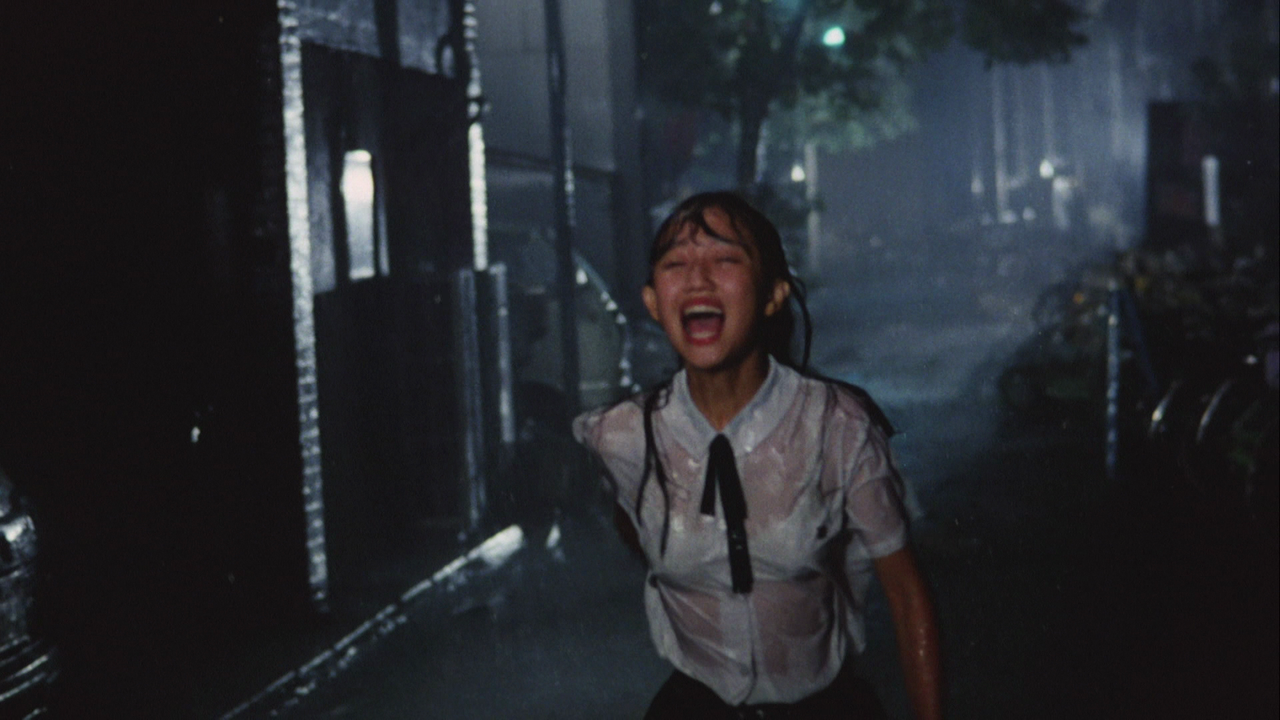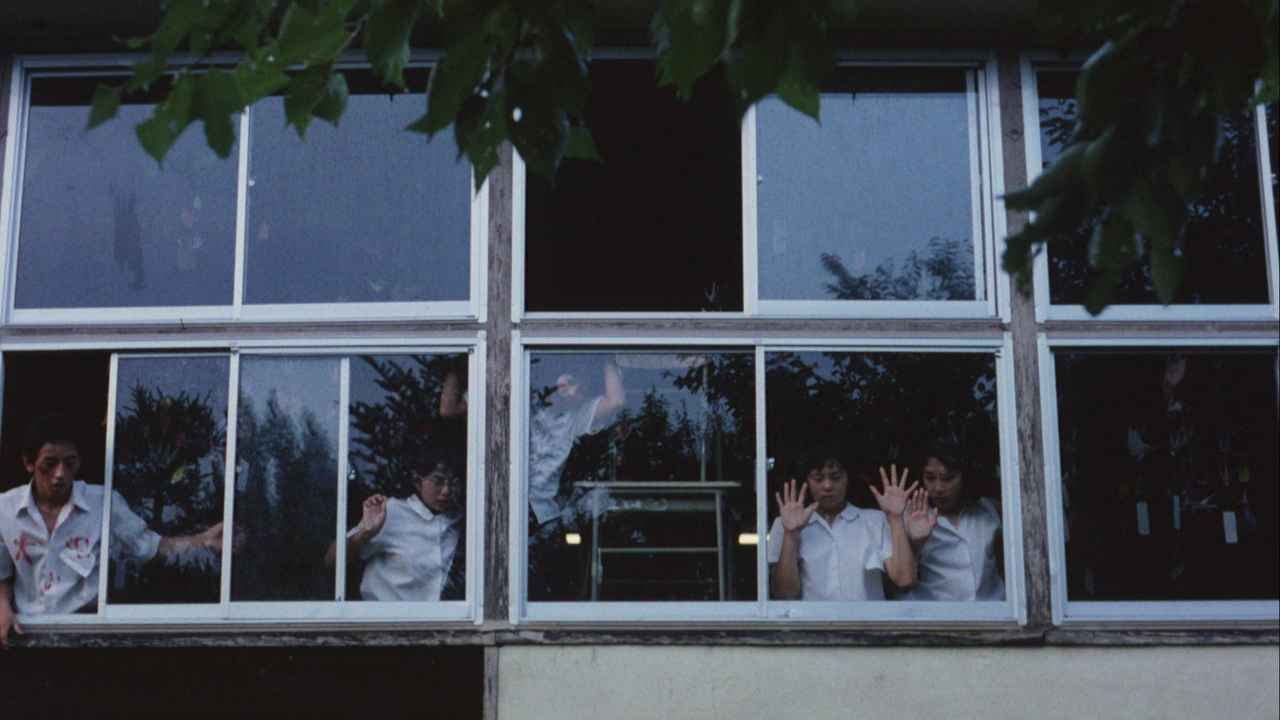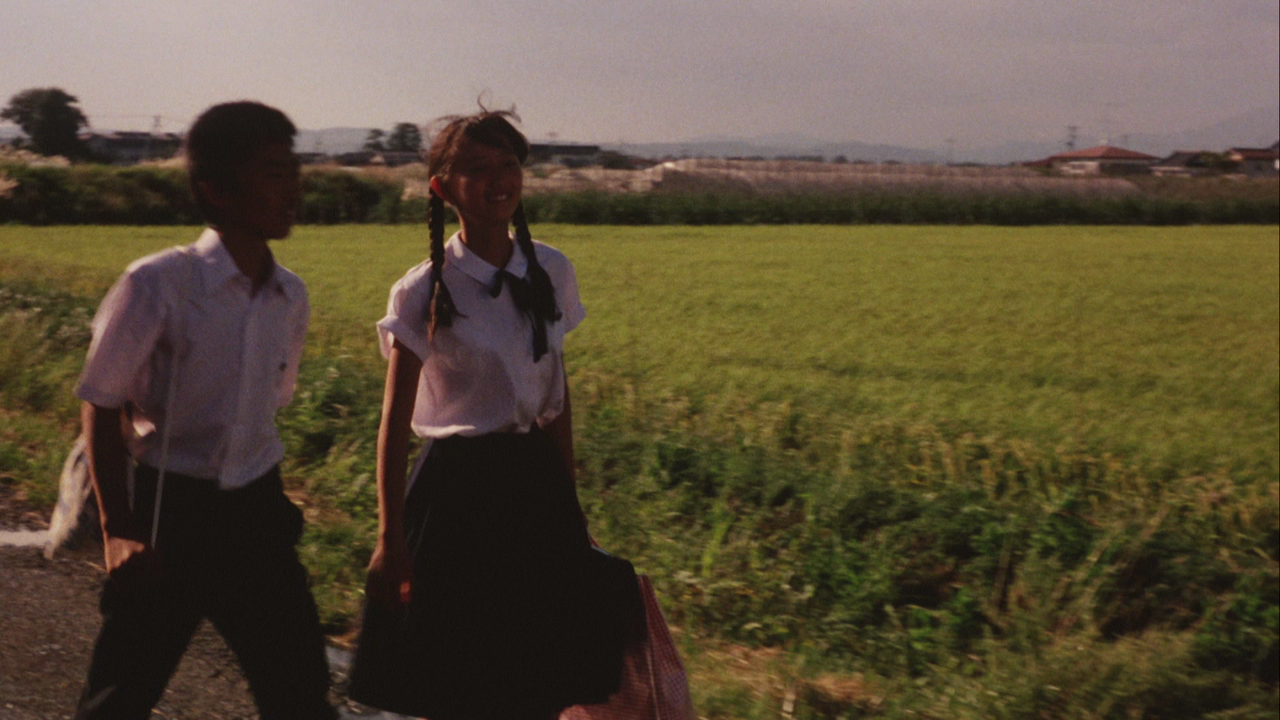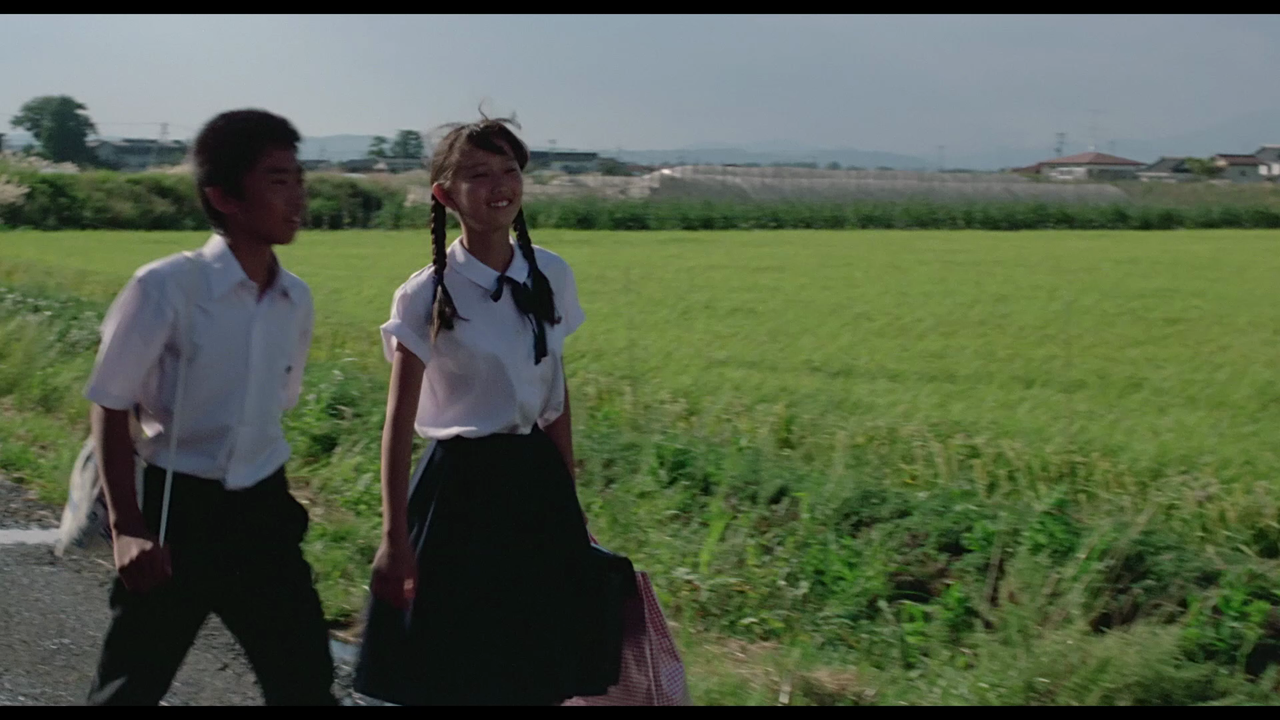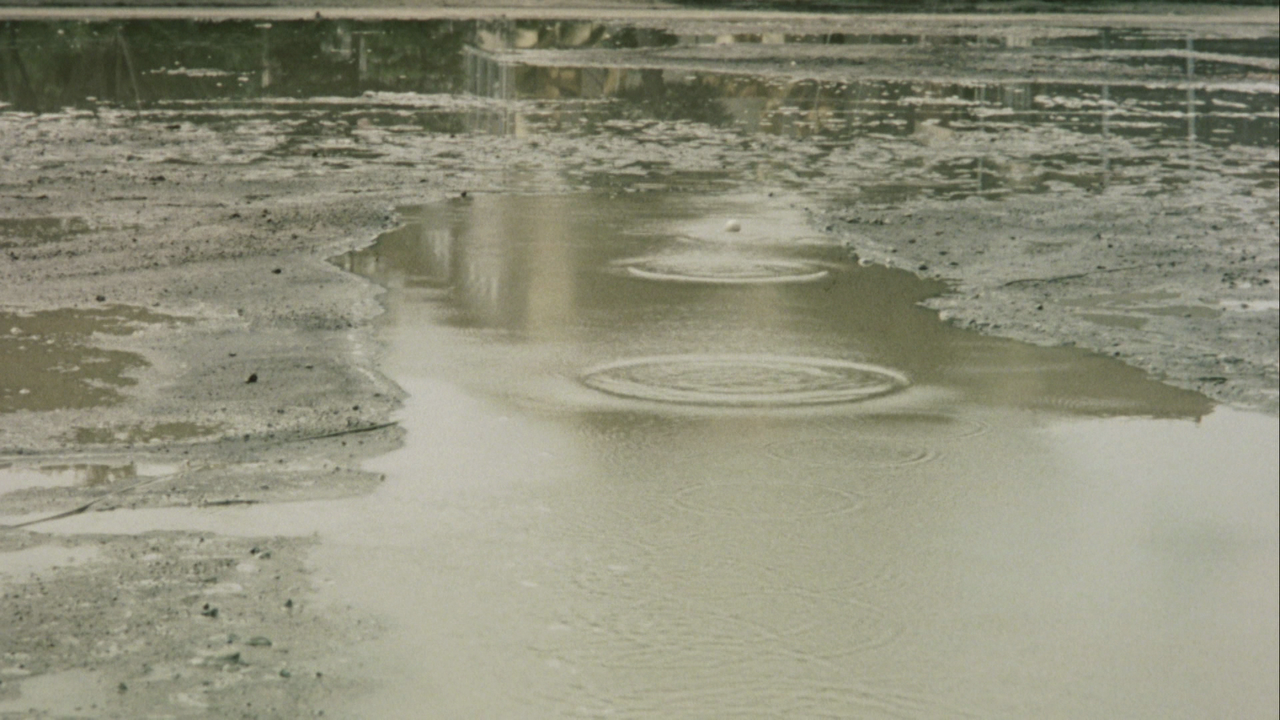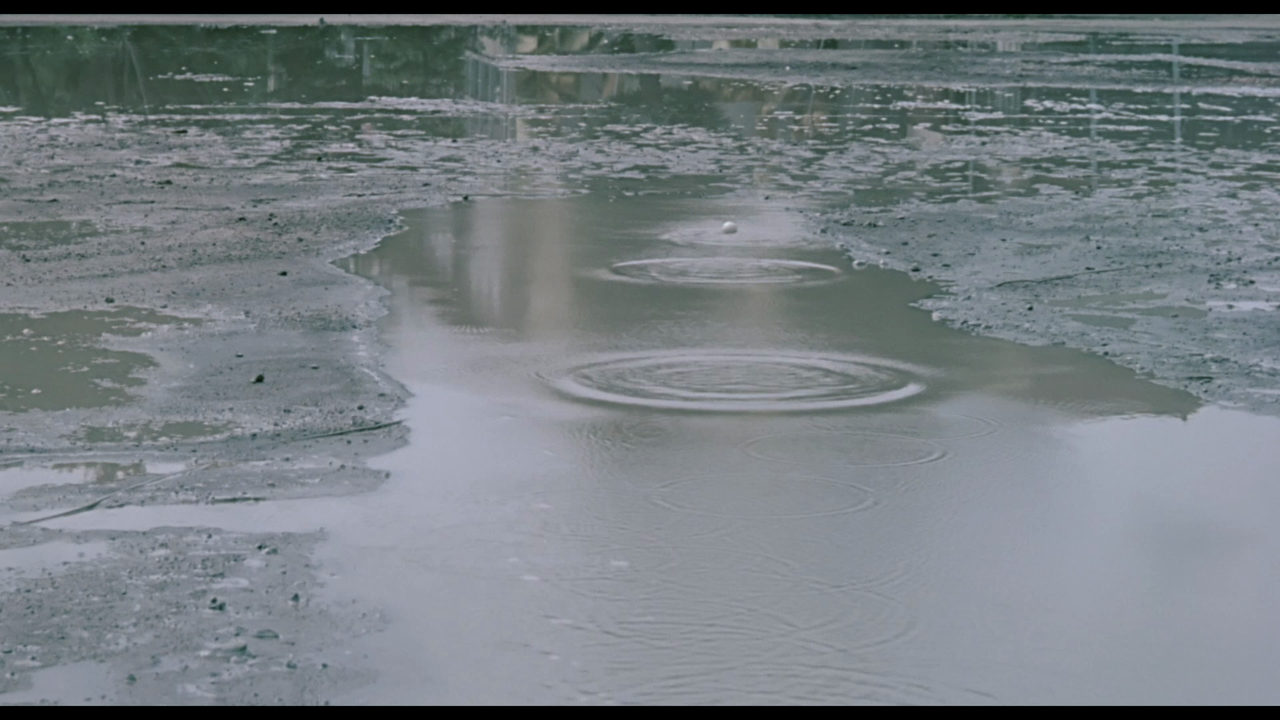#179
Post
by feihong » Fri Dec 15, 2023 6:40 am
Now that I've seen the film theatrically, I'd say both these Typhoon Club blu rays leave a lot to be desired. The Japanese disc has visible film grain––but it's very soft, and the image itself seems unrestored, very dark all over, with a bias towards blues. The disc has depth-of-field and the shots have lots of visible textures in them (textures of skin, textures of the school buildings, texture of the light passing through the rain, etc.), but many scenes are pretty unacceptably dark, including the opening pool scene and Ken's lengthy attempted rape of Michiko. When the rain gets too thick, the detail is very indistinct because of the darkness. The Third Window disc has the much brighter remaster without the blue bias, making a lot of the movie more visually distinct––but the effect of the grain management is brutal, softening the picture, flattening all the color spaces in the image. So while the darker scenes in the movie are now much easier to see thanks to the restoration, the lack of grain makes it look like every image is smeared with vaseline, and there's really never a point where you can clearly perceive background detail, for instance. Very weird. The scene in the shopping arcade, with the couple playing flutes, offers a different view of the two discs. Generally the color and contrast of the restoration on the Third Window disc is closer to what I saw theatrically, but in the shopping arcade scene, the image on the Japanese disc is much truer. When I saw it theatrically, there was light cascading through the raindrops in front of the camera, lighting the raindrops a sort of brilliant red. You can see that on the Japanese disc, but on the Third Window disc the raindrops look very dull, and don't seem to have any special lighting to them at all. The immediate next scene, however, both discs revert to type. In that scene, Mikami sits on a filing cabinet behind the origami cranes in the classroom, and on the Third Window disc his face and body are very distinct––but on the Japanese disc, he seems to be crouched in some encroaching shadow.
Tom Mes' commentary on the Third Window disc is interesting. He goes into a lot about the Director's Company and a lot about the actors in the film. He shares some fascinating production tidbits––apparently there was no inclement weather on the shoot, and the typhoon is created wholecloth by the production team and production designer Noriyoshi Ikeya (who worked initially on Ultraman, doing a lot of early creature designs, and who did production design also on Akio Jissoji's movies, on Shuji Terayama's Farewell to the Ark, and on Seijun Suzuki's Kagero-za and Yumeji, amongst other films). He frequently talks about Yuka Ohnishi, who plays Michiko. Of the leads in the film, I'd say I pay probably the least attention to Michiko, and so I never thought to look up anything about her. She was a very successful recording artist, and one of the backup stars in Sukeban Deka III and some of the subsequent Sukeban Deka movies (she's the one who fights by throwing origami cranes at the villains). Honestly, she seems to me to be playing the role of Michiko here because her face, her body––her voice, even––are permanently clenched. I think she's always embodied a kind of uncomfortable unease, as an actress...even her voice sounds uncomfortable singing her songs. She's perfectly cast for this film, but later on she looks to me the most uncomfortable movie star I can think of this side of, I don't know, Tea Leoni.
Mes has read the script to the film, so he knows more about the intent behind certain scenes, perhaps, but I found I had some different readings of what was happening some of the times when the commentary would briefly drift into analysis of what we were seeing. He seems to regard the teacher as a cad, and he frequently references the scene where Sensei Umemiya is confronted in the classroom by his girlfriend's mother as being dispositive of this. The suggestion Mes makes is that Sensei Umemiya is a stand-in for the let-down adults prove for the children of the film. He describes the scene between Umemiya and Junko afterwards as indicative of passion between them. But the dialogue in the scene tells a very different story, I think. The confrontation scene in the classroom paints Umemiya as a cad who borrowed a lot of money from Junko and refuses to marry her. The scene between them in Umemiya's apartment later reveals that Junko left Umemiya for another guy, who was the one who borrowed Junko's money and ran away with it. When we next see Umemiya at home, he's getting drunk and singing karaoke with Junko, Junko's mother, and her uncle––which is where Mikami confronts him over the phone, and we get that maybe most important line of the movie, where Umemiya says to Mikami that he'll turn out to be the same as Umemiya when he grows up. "One day you'll realize that you're just...like...me." What's the purpose of that line in the movie? Right before he says it, Umemiya looks in on his would-be in-laws, and Junko's uncle has just let down his robe to reveal a yakuza tattoo. Mes says this is probably an in-joke, about how many yakuza actor Makoto Sato has played in the past, but I think the point of this is to show the threat of commitment that Umemiya faces. He's getting into bed with Junko, who doesn't really seem to love him anymore, and now he's getting into bed with her family––not a group we're at all happy about from what we've seen already in the movie. The point of the scene is compromise, and Umemiya is telling Mikami over the phone that he'll end up compromising his ideals eventually, and that somewhere down the line, he'll be on the other end of the phone call, telling off his own smartass student. So going back to the scene between Umemiya and Junko, I don't think what we're seeing is any passion, so much as Junko trying to convince Umemiya that their marrying has now become the path of least resistance. Umemiya thinks that he let her wait too long, and maybe it's true. But the real sense we get, I think, is that they'll both be compromising here––and their next scene is, indeed, a farce of compromise, where they both have to get pretty drunk in order to fake that they're having a good time with Junko's overzealous family.
Mes also suggests that when Rie oversleeps on the day of the typhoon, and misses Mikami going to school, that she climps into her mother's futon to feel her mother's warmth and smell. That could be in the script, I guess. But it looks and sounds to me like Rie is supposed to be masturbating in her mother's futon. That was certainly the feeling the audience felt in my theater when I saw it––a couple of people got up and walked out on that scene. I think the trajectory of Rie's character is helpful in determining this. Rie's character arc, as I see it play out, goes like this: 1) After the girls nearly strangle Akira in the pool, Rie sees Akira's erection before anyone else, and is shocked by it. 2) Rie tries to paper over the sexual nature of the girls' teasing of Akira to Mikami the next day. Rie spends most of the next day trying to get Mikami's attention––unsuccessfully. Mikami wants to study, and then when Rie corners him at home, Mikami goes out to hang out with his guy friends, Ken and Akira. In this scene it's clear Mikami feels no special attraction to Rie, and doesn't think of her as his girlfriend––even though Rie clearly thinks of Mikami as her boyfriend. 3) At this point Rie is in a highly-agitated mood. She misses her chance to walk to school with Mikami––her mother was out and didn't wake her up––one reason why Rie probably isn't trying to capture her mother's warmth in the empty futon (also, Rie doesn't spend any time in the futon smelling anything––instead, we see a bunch of movement constricting the comforter, and we hear a bunch of pants and moans). Here is where, I think, she masturbates in an attempt to release some of the pent-up tension she's facing. 4) Rie arrives and the school crossroads near lunchtime. She sits on the ground, trying to decide what to do. An idea flits through her mind––an adventure. The publicity stills of Rie sitting on the concrete seem to be from this scene, but there are crucial differences between them and what is filmed. In the publicity stills, Rie looks unhappy, unfulfilled, even melancholy. In the film, she is smiling almost euphorically, and there's a sense that the smile is somewhat dissonant from how we might expect to find her. She's taken, here, by the chance to escape: to slip the routine of her life and have an adventure (she admits as much a couple of scenes later)––or maybe to leave the countryside behind for good, and make a new future for herself in the city. 5) When next we really see her, Rie has made it to Tokyo, has found a guy (Toshinori Omi, star of a bunch of Nobuhiko Obayashi's movies––even though Mes compares and contrasts Obayashi and Somai frequently in the commentary, he mentions others of Toshinori's credits, but never references the way he was clearly a sort of totemic actor for Obayashi, appearing in cameos in Obayashi films long after he was no longer the star of the pictures). The guy takes her shopping––everything in Rie's fantasy is working out so far. 6) Kobayashi (Toshinori Omi's character) takes her back to his apartment, and clearly intends to sleep with Rie. Rie's fantasy is turning a different shade than what she wanted from it, and she has a moment of self-realization, expressed by her monologue––she doesn't want to be trapped, getting old in the countryside. Mikami, if he is talented enough academically, will leave, and Rie––no one special to Mikami, she has come to realize––will be left there, growing old in the countryside, being some farmer's wife, getting worked to the bone. But she also realizes that she doesn't want what Kobayashi is proposing, and she ditches him. 7) Rie's experience in the city turns sour. She is repeatedly prey for the typhoon, and she's alone (there's actually a fake police officer, a life-size display of a cop, which she trips over––and he doesn't come to her rescue). She sings her school song into the wind in defiance. She starts home. 8) Rie encounters the couple tied to each other, playing the flutes. Are they a projection of her future? is she seeing herself, tied to Mikami forever? The figures appear grotesque and alien to her, and though she wants to understand them, they remain closed off and inaccessible to her. 9) Rie returns to school the next day. She's seen visions of the future, she's stared into the typhoon––she is tougher than when she left, more resilient against growing up. When she meets Akira on the road, she asks him if he got taller over the night––but she's really maybe thinking about herself here. Akira certainly seems to be his goofy self here (we learn in this final scene why he was at the pool at night in the first scene of the picture––if he doesn't escape home at night, his parents scold him constantly until he can't stand it), and he runs off to play in the mud. Rie has grown up a bit. She makes a literary allusion to the Golden Pavilion. That allusion is perhaps not accidental––the Mishima novel is about a man who longs to sacrifice himself for an ideal––and Somai has just finished showing us Mikami––unmoored after Rie leaves him––attempting to sacrifice himself for an equally absurd ideal. In fact, one gets the sense that Rie and Akira are about to encounter Mikami's absurd corpse (Mes does point out that this death is an allusion to Kon Ichikawa's film The Inugami Clan, which features a murder with the victim's legs sticking out of a lake in the same way). The mother/abandonment theme certainly fits with the rest of the story, but I think that at the point Rie gets into her mother's futon, the film has been setting up her character to be frustrated and horny. Her adventure plan continues in this vein––she is actively looking to get it on with some guy from the city––but at the moment it's going to happen, she's overwhelmed, and more than a little frightened, and she essentially runs away. So if Rie isn't masturbating in her mother's futon, there's far less of a through-line for her character's evolution. Interestingly, Mes never mentions the missing scene I identified, where the lesbian girls apparently have some sort of altercation with Mikami, Ken and Michiko––the point at which Yasuko gets her uniform torn up and gets her hair taken down. Very clearly something was filmed and then cut––Yasuko suddenly has a bloodied scab on her forehead in the gymnasium scene, and her uniform has been just wrecked beyond repair––but there's no scene in the movie where this happens. I don't mean to be criticizing Mes, who does a hero's job introducing a great filmmaker nobody in the west has ever heard of. I just can't help but pick apart the way I think a movie works, vs. the way other people think it does. In his early films, I think Somai really admires characters like Rie, who weather all the hardships and challenges thrown at them and embrace life with arms open wide––even if these characters are, say, dumber than the sharper characters in any given Somai picture. In fact, Somai's more intellectual characters are ones he frequently mocks. Mikami gets the brunt of that, here––we feel that even Ken, the witless would-be rapist, is more admirable a character in Somai's eyes than Mikami––who dies not for the ideal he drives at (an ideal I think Somai makes clear is just an expression of Mikami's sense of intellectual superiority and entitlement), but rather because the way the other children give in to their so-called "basest" instincts during the typhoon intimidates and emasculates him. But Rie, who returns from the city bent but unbroken, is more Somai's idea of a "hero." You see similar characters in Lost Chapter: Passion in Snow (here it's adorable original Sukeban Deka star, Yuki Saito, played as awkward, almost slow-witted, but sensitive) and Luminous Woman (Sensaku is perhaps Somai's dumbest protagonist, yet Somai is determined to make him virtuous), and protagonists of Tokyo Heaven, Moving and The Friends are intellectually stunted just by being young––it's their resilience Somai admires (though I'd say the resilience of Renko in Moving is a little more forced than what we see in the other movies). Somai seems so much more ready to value Rie, Michiko, and even Akira and Ken before he values Mikami. Rie's adventure, perhaps designed to humiliate and endanger her, is a challenge she surmounts and grows from; Mikami's adventure takes him to the essence of humankind. It chafes against his pristine, virgin soul, and he would ultimately rather die than face the challenges ahead. Mikami's death-splits––even as an allusion to another film––is meant to show how stupid and short-sighted is his cowardice. By that logic, Umemiya isn't so much a stand-in for parental indifference as he is a man who has hesitated in the past, but whom Somai is giving a sort of reprieve, because has finally committed, and is charging ahead. The compromise Umemiya is making (marriage) alienates Mikami, who was his erstwhile fan in the past (he refuses to join Michiko in her outrage at Umemiya's girlfriend's family's interruption of class, and there's a shot during that conflict of Mikami looking up at the teacher with a sort of bemused admiration). Mikami doesn't recognize what Umemiya is doing as committing to a path. I guess Mikami doesn't recognize such commitment as success unless it avails Umemiya of the kind of superiority Mikami longs to feel. Meanwhile, Mikami commits to the horny madness of the typhoon, with his classmates––but then instantly repudiates it when the storm has passed, and then builds a literal throne for himself out of desks, and tries to make a grand exit––something Somai immediately undercuts, because as a filmmaker, he only respects the characters who embrace life, not the ones who manufacture a grand fate for themselves (Lost Chapter: Passion in Snow does something similar with Yuki Saito's love interests).
Amazon.co.uk lists "Selected audio commentary by Josh Slater-Williams" as an extra on the Third Window blu ray, but I can't find it anywhere––and the film only has two audio tracks––the Japanese soundtrack and the English-language commentary track with Tom Mes. The other extras mentioned do seem to be there.
At the end of the day, though...why oh why, is the grain in these films so hard to capture? I'm watching Lost Chapter now––it has slightly softer grain than Typhoon Club––whereas the trailer on the disc is full of grain and looks diamond-edged sharp. I hope Cinema Guild is able to work this out.
